The Goddesses of Rome
Proserpina: Goddess of the Seasons and Queen of the Underworld
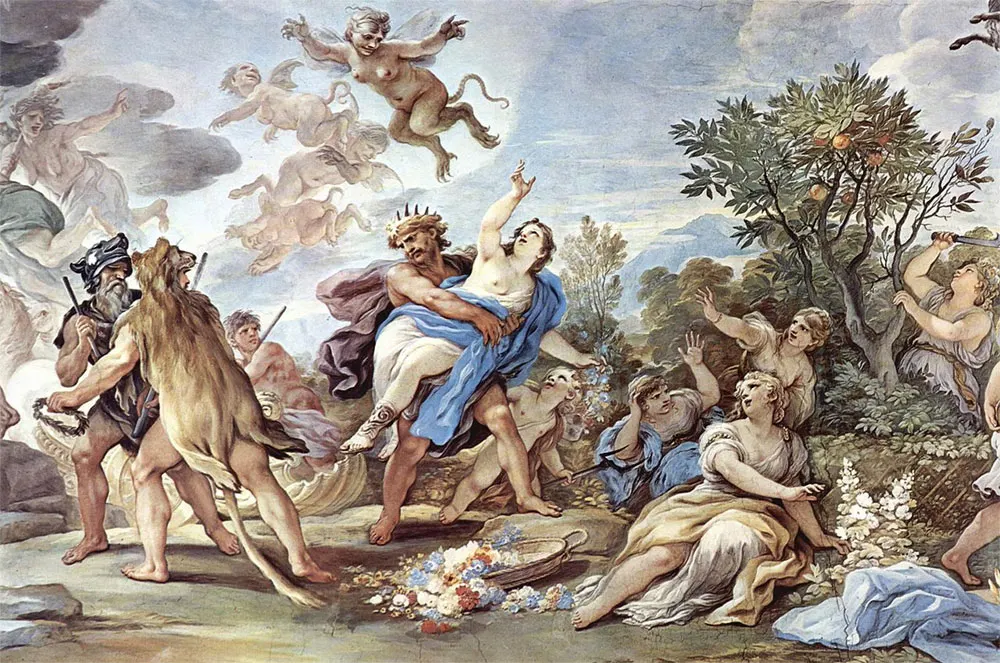
Source: Weird Italy
In Roman mythology, the goddess Proserpina, also called Persephone in Greek mythology, carries dominion over the nature of the seasons and the underworld. However, Proserpina’s influence goes far beyond the realm of Roman mythology and resonates in various cultural contexts and belief systems. The story of her abduction by Pluto and her subsequent reign in the underworld symbolizes her status as the Queen of the Dead and the Goddess of Spring and Rebirth. This dual nature symbolizes her sovereignty over the never-ending cycle of life, death, and resurrection.
Overview of Proserpina
Proserpina’s name is derived from the Latin words “proserpere” or “proserpens,” signifying “to emerge” or “to creep forth (WeirdItaly).” Proserpina was assimilated with the ancient Roman fertility goddess Libera, whose central cult was in the Aventine temple of the grain-goddess Ceres and the wine god Liber. It is worth noting that Proserpina was introduced from southern Italy as part of an official religious strategy towards the end of the Second Punic War. The Roman society suffered from crop failures, intermittent famine, and hostility between the lower and upper social classes. Roman impiety believed these occurrences were divine retribution, necessitating this official religious strategy (Wikipedia Contributors).
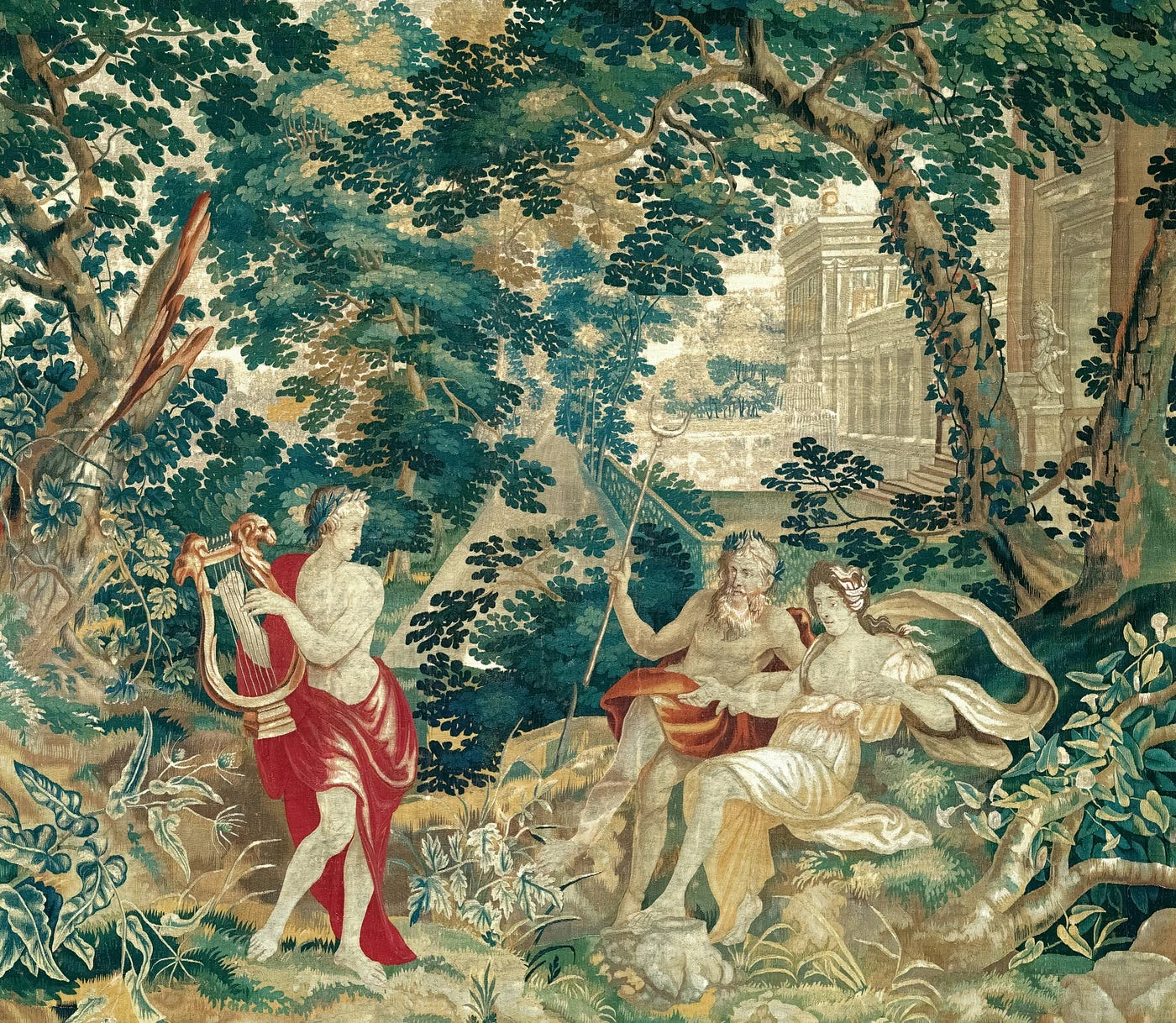
Source: Medium
Titles
Queen of the Underworld
Goddess of Spring and Rebirth
Goddess of Fertility
Mistress of Souls
Abilities
Proserpina possesses remarkable abilities, among which is her control over the seasons. During winter, as she descends into the underworld, the earth turns barren and lifeless, mirroring her absence from the surface world (Wikipedia Contributors). This period of dormancy symbolizes the harshness of winter, but Proserpina’s return each spring heralds a transformation. Her presence ushers in the resurgence of life and fertility as the earth bursts forth with blooms and greenery (“THE STORY OF WINTER”). This control over the changing seasons highlights her role as a vital force in the natural world and underscores her connection to the perpetual cycle of renewal and growth.
Furthermore, as the Queen of the Underworld, Proserpina holds authority over the souls of the departed. Her dominion extends to judging and guiding these souls, determining their fate in the afterlife. This role emphasizes her importance in the spiritual realm and significance in the Roman concept of the afterlife (Wikipedia Contributors). Her dual role as a goddess of life and death reflects the intricate balance between these two fundamental aspects of existence. Her abilities to control the seasons and preside over the realm of the departed make her a central figure in Roman mythology, embodying the cyclical nature of life, death, and rebirth.
Characteristics
Proserpina’s appearance and demeanor have been depicted in Roman art and literature as possessing an ethereal and captivating quality. She is often portrayed as a young woman of extraordinary beauty, with an otherworldly allure that distinguishes her from mortals. This emphasis on her divine nature underscores her significance as a goddess in Roman mythology.
Her flowing hair is one of the most notable aspects of her appearance, depicted in shades of gold and dark hues. This imagery symbolizes the transition between the realms of the living and the dead, as her hair mirrors the changing seasons (WeirdItaly). The golden hues evoke the warmth and vitality of spring, while the darker shades represent the sameness of winter. This dual-toned portrayal reinforces her role as a goddess, serving as a bridge between life and death.
This artwork portrays Proserpina in deep slumber beneath the earth as winter spreads its effect throughout the landscape. In her dreams, Proserpina envisions the arrival of spring, where she is awakened and walks amidst the rejuvenating nature of the season.
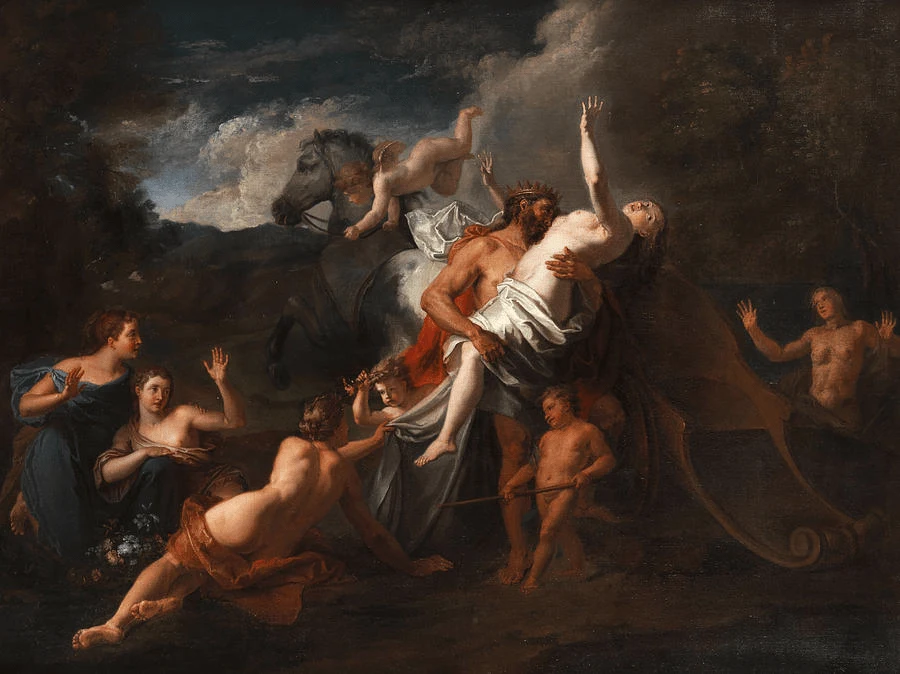
Source: Fine Art America
Traits
Proserpina is a fascinating figure with a multifaceted character. Her association with the underworld and judgment of souls might suggest a lack of compassion and mercy, but in reality, she exhibits these qualities. She is often depicted as comforting, offering solace to the departed and consoling those mourning their loved ones (Wikipedia Contributors). Proserpina’s empathetic nature is a testament to her understanding of the afterlife. In addition to her compassion, Proserpina’s story also highlights her resilience. Her abduction by Pluto and subsequent role as Queen of the underworld and goddess of spring illustrate her ability to adapt to challenging circumstances (“THE STORY of WINTER”). Her resilience is comparable to the cyclical nature of life and death, and she navigates the transitions between these realms with grace and strength.
Lastly, Proserpina is a figure of mystery and intrigue. Her story is shrouded in enigma, mirroring the mysterious nature of the underworld itself. Her dual role as both a benevolent goddess of rebirth and a powerful queen of the dead adds complexity to her character, making her a fascinating and curious figure (WeirdItaly).
Symbols
The symbols associated with Proserpina in Roman mythology are profound and richly significant. The pomegranate stands foremost among them, representing her binding to the realm of the dead when she consumed its seeds while residing with Pluto in the underworld (Wikipedia Contributors). This symbolism underscores the interconnectedness of life and death and the cyclical nature of the seasons, where winter’s dormancy ultimately yields spring’s renewal. Another prominent symbol of Proserpina is the torch, which she often holds as the Queen of the underworld. This imagery emphasizes her role as a guide for souls navigating the afterlife while highlighting her connection to the light and warmth of the surface world. The torch also signifies the rekindling of life with Proserpina’s return in the spring, further underscoring her role in the cycles of nature and the land’s prosperity.
In addition to these symbols, grains and wheat are closely associated with Proserpina, emphasizing her pivotal role in agriculture and fertility (WeirdItaly). These symbols highlight her ability to ensure bountiful harvests and the earth’s rejuvenation each spring, making her a goddess closely tied to the cycles of nature and the land’s prosperity. Proserpina’s significance in Roman mythology is profound and enduring, and her symbols resonate with people today.
In the depicted illustration, Proserpina adorns an elegant purple off-the-shoulder dress, gracefully holding a blue robe and a pomegranate in her hand.

Source: Glorian
Festivals and Rituals
The Cerealia festival was a significant annual event dedicated to Proserpina, the goddess of agriculture and fertility in Roman mythology. It was celebrated in April and aimed to invoke the deity’s blessings upon the land, ensuring a prosperous harvest for the people. The festival’s central focus was on offerings that symbolized the fertility of the earth and the hope for a bountiful agricultural season. In particular, grains were a prominent feature, underscoring Proserpina’s association with agriculture. Additionally, flowers were presented as offerings, reflecting the blossoming of spring that coincided with Proserpina’s return from the underworld (“THE STORY of WINTER”). The Cerealia festival served as a testament to the Roman people’s dependence on Proserpina for agricultural success and the renewal of life each spring. It reinforced her role as a vital force in the cycle of seasons and the land’s prosperity.
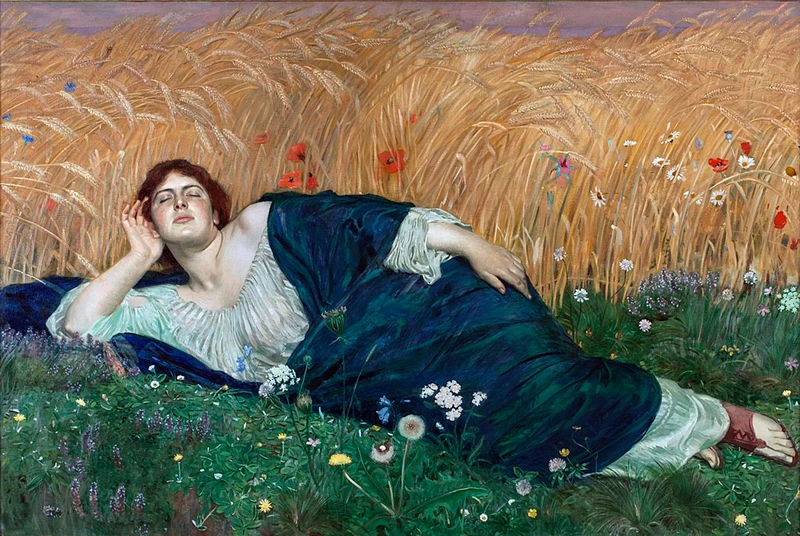
Source: Espores
Legends associated with Proserpina
Proserpina is an enigmatic goddess of remarkable depth and complexity. Her rich mythology is intricately woven with a myriad of fascinating tales that have captivated the imaginations of countless cultures across the ages.
Origin story
The origins of Proserpina, as depicted in Roman mythology, are deeply rooted in familial ties and symbolic representations of fertility and prosperity. According to the myth, Proserpina was born as the cherished daughter of Ceres, the goddess of agriculture and grain, and Jupiter, the mighty king of the gods (Wikipedia Contributors). Her birth was celebrated as a moment of great joy and promise, as she was seen embodying the vital forces of nature and the sustenance of life. As the daughter of Ceres, Proserpina held significant implications for the bountiful harvests and prosperity of the Roman people.
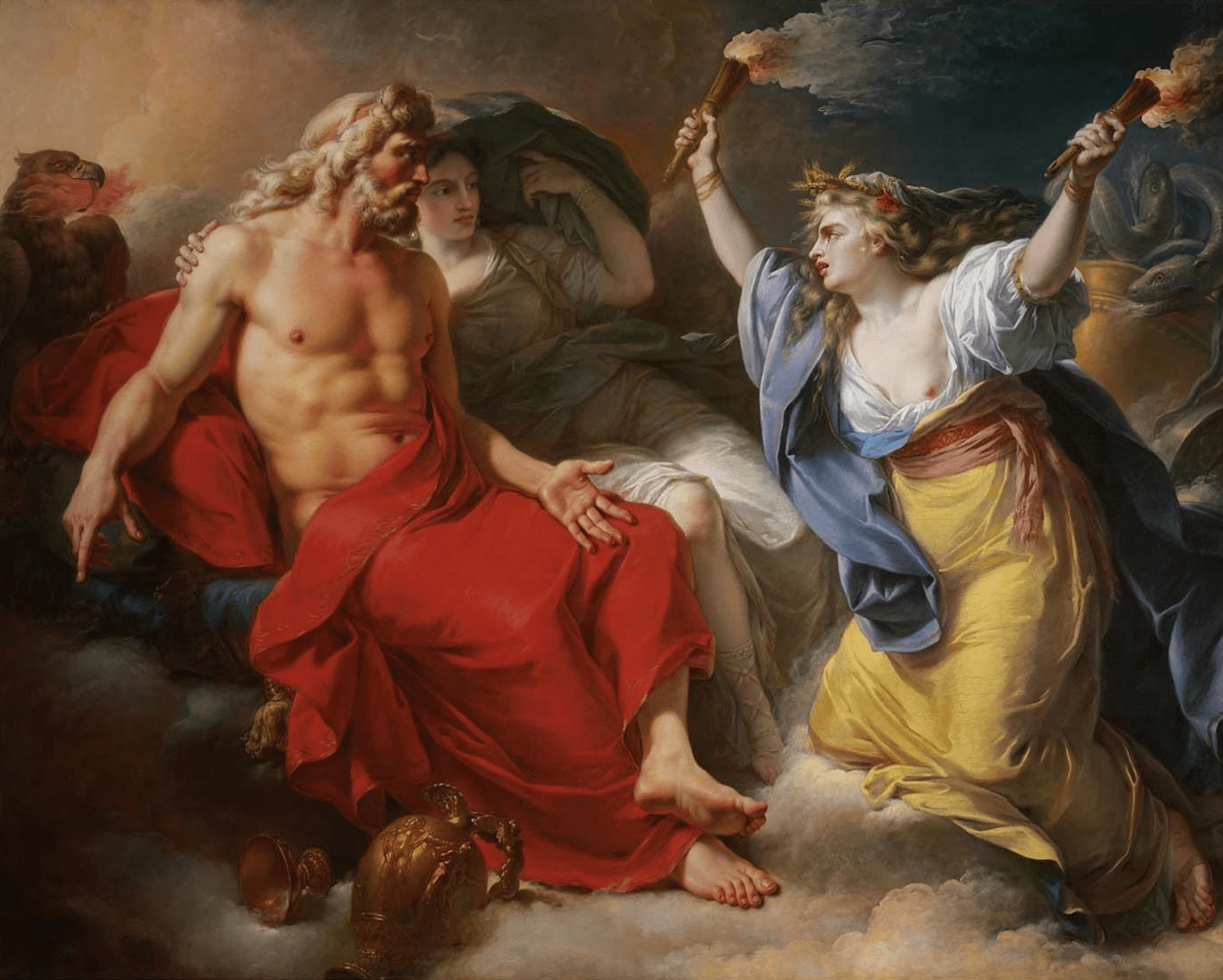
Source: Wikimedia Commons
The Rape of Proserpina
The abduction of Proserpina by the god of the Underworld, Pluto, and her mother, Ceres’ frantic search for her is a widely known legend. Proserpina’s eventual but temporary restitution to the world above resembles the Greek myth of Persephone’s abduction by Hades. In Claudian’s De Raptu Proserpinae (poem), Pluto yearns for the joys of married love and fatherhood and threatens to wage war on the other gods to prevent the outbreak of war. In fulfillment of the prophecy, Jupiter orders Venus to bring love to Pluto. Ceres attempts to conceal her innocent daughter, Proserpina, by sending her to safety in Sicily, Ceres’ earthly home and sanctuary. Nevertheless, Pluto emerges from the volcano at Mount Etna in his chariot, seizes Proserpina at the Pergusa Lake near Enna, and takes her down into the underworld. The poem concludes at this point (Wikipedia Contributors).
Proserpina’s mother, Ceres, searches for her daughter worldwide, but to no avail. As Ceres walks the earth, the sun sinks, darkness falls, and with each step, the growth of crops halts, creating a desert. Jupiter sends Mercury to order Pluto to free Proserpina, but she has eaten “several” of the pomegranate seeds from the underworld; those who have eaten the food of the dead cannot return to the world of the living. Pluto insists that she had willingly eaten his pomegranate seeds and, in exchange, she must stay with him for half the year. When Ceres welcomes her daughter’s return to the world of the living, the crops grow, flowers blossom, and in summer, all growing crops flourish to be harvested in autumn (Wikipedia Contributors).
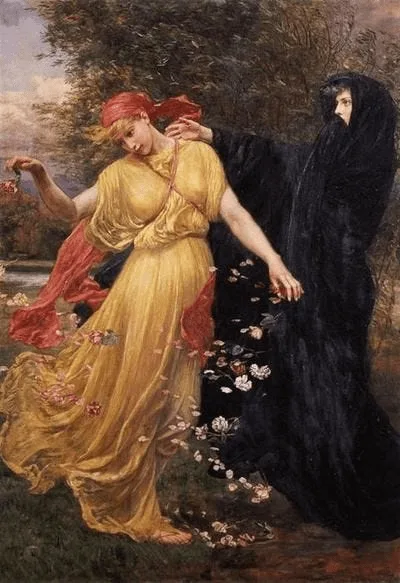
Source: Medium
The Demonic Paradise
The myth of Proserpina is a subject that has been explored in various works of literature over the centuries. One particularly moving story that shares similarities with the tragic tale of Orpheus and Eurydice is recounted in Claudian’s work from the 4th century AD (Wikipedia Contributors), known as “The Demonic Paradise.” Virgil’s Georgics tells the story of Orpheus and Eurydice with heart-wrenching detail, as Eurydice tragically dies from a snakebite, leaving Orpheus shattered by her loss. In his grief, Orpheus ventures into the underworld, relying on his musical talents to guide him, and pleads with Proserpina to be reunited with his beloved wife.
Proserpina, moved by Orpheus’ enthralling music and sincere plea, grants him a conditional opportunity: he may lead Eurydice back to the land of the living only if he does not look back at her during their journey. This condition adds an element of suspense to the story, as Orpheus must navigate the dangerous path from the underworld to the world of the living, relying on his faith and love to guide him. Regrettably, Orpheus succumbs to the temptation and casts a fatal backward glance at Eurydice, condemning her to remain forever in the realm of the dead. By doing so, he denies himself the pleasure of her company in the world above, which is now beyond his reach (“Proserpina”).
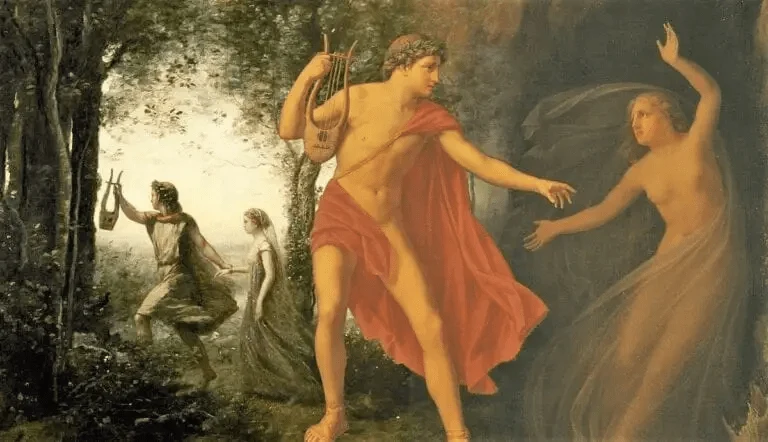
Source: The Collector
Influences of other religions/cultures on Proserpina
The narratives of Proserpina and Persephone in Roman and Greek mythology, respectively, share striking similarities, particularly in their abduction by Pluto (in the Roman version) and Hades (in the Greek version), which sets off a sequence of events involving their grief-stricken mothers and eventual return to the surface world (Wikipedia Contributors). This intriguing resemblance can be attributed to the significant influence of Greek culture and mythology on Roman society, as the Romans embraced and incorporated many aspects of Greek religion and deities. Consequently, Proserpina and Persephone are often regarded as interchangeable deities due to the extensive overlap in their qualities and tales. The enduring appeal of these goddesses is a testament to the cultural exchange and fusion of Greek and Roman beliefs, emphasizing their shared significance as underworld figures and symbols of the seasonal cycle in both mythologies.
Modern appearances
The myth of Proserpina, the ancient goddess of the underworld, has left an indelible mark on modern culture and creative expression. Her tale of abduction by Pluto and subsequent sojourn in the underworld has been retold in various forms of art and literature with exquisite detail. Examples of such art pieces include Bernini’s “The Rape of Proserpina” and Rossetti’s “Proserpine.” In literature, Ovid’s “The Metamorphoses” has influenced Proserpina’s myth and inspired countless retellings (Wikipedia Contributors). Contemporary works such as Melissa Bashardoust’s “The Myth of Persephone in Girls Made of Snow and Glass (“Goodreads”)” and Kate Forsyth’s “Proserpina and the Pomegranate” are modern retellings that offer fresh perspectives on the classic myth. These books explore themes of power, identity, and the mother-daughter relationship in imaginative ways, weaving elements of history and mythology to create rich and compelling narratives. Proserpina’s enduring influence inspires new interpretations and creative works that delve into the complexities of these timeless themes.
The musical Hadestown tells the joint stories of Orhpeus and Eurydice as well as the stories of Persephone/Proserpine and Hades/Pluto.
Final thoughts
Proserpina’s enduring significance within mythology is rooted in her complex character and mastery over the seasons. Throughout history, her story has been intertwined with that of Persephone in Greek mythology, reflecting the cultural exchange typical in ancient times. Even in modern times, Proserpina’s influence can still be felt in various forms of art, literature, and popular culture, where she symbolizes transformation and renewal. Proserpina continues to inspire and offer insights into the profound forces of nature and the human condition as a symbol of the eternal cycles of life, death, and rebirth.
References
“Goodreads.” Goodreads, www.goodreads.com/en/book/show/32768509. Accessed 7 Sept. 2023.
“Proserpina.” The Demonic Paradise Wiki, the-demonic-paradise.fandom.com/wiki/Proserpina. Accessed 7 Sept. 2023.
“THE STORY of WINTER.” Nybg.org, 2019, sciweb.nybg.org/science2/Onlinexhibits/THE%20STORY%20OF%20WINTER.htm.
WeirdItaly. “Proserpina, the Queen of the Underworld.” Weird Italy, 6 Oct. 2022, weirditaly.com/2022/10/06/proserpina/. Accessed 7 Sept. 2023.
Wikipedia Contributors. “Proserpina.” Wikipedia, Wikimedia Foundation, 21 Oct. 2019, en.wikipedia.org/wiki/Proserpina.
Aurora: Goddess of Dawn
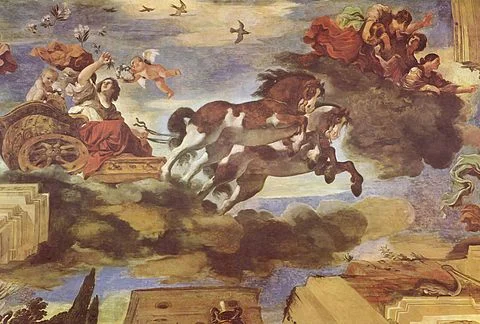
Source: Wikipedia
The goddess Aurora has long been revered for her role as the bringer of dawn. In ancient Roman mythology, her radiant presence was said to signal the beginning of a new day and the promise of new opportunities. As the Goddess of Dawn, Aurora's otherworldly beauty and grace were an enchanting sight to behold, and her luminous light cast a spell over all who witnessed it.
It is said that Aurora's light has the power to dispel even the darkest shadows, bringing hope and renewal to all who are fortunate enough to experience it. For centuries, people have looked to her as a symbol of new beginnings, a reminder that even in the darkest of times, there is always the promise of a brighter tomorrow (“Aurora, Roman Goddess of Dawn: Mythology & Powers | Who Is Aurora?”).
Overview of Aurora
Aurora, often called Eos in Greek mythology, is the Roman goddess of dawn and is closely associated with the break of day. Her appellation is derived from the Latin term "aurora," which denotes the rising sun and the illumination it brings to dispel darkness (“Aurora (Mythology)”). Different names across various cultures know the goddess, yet her essence as the bringer of light remains consistent throughout.
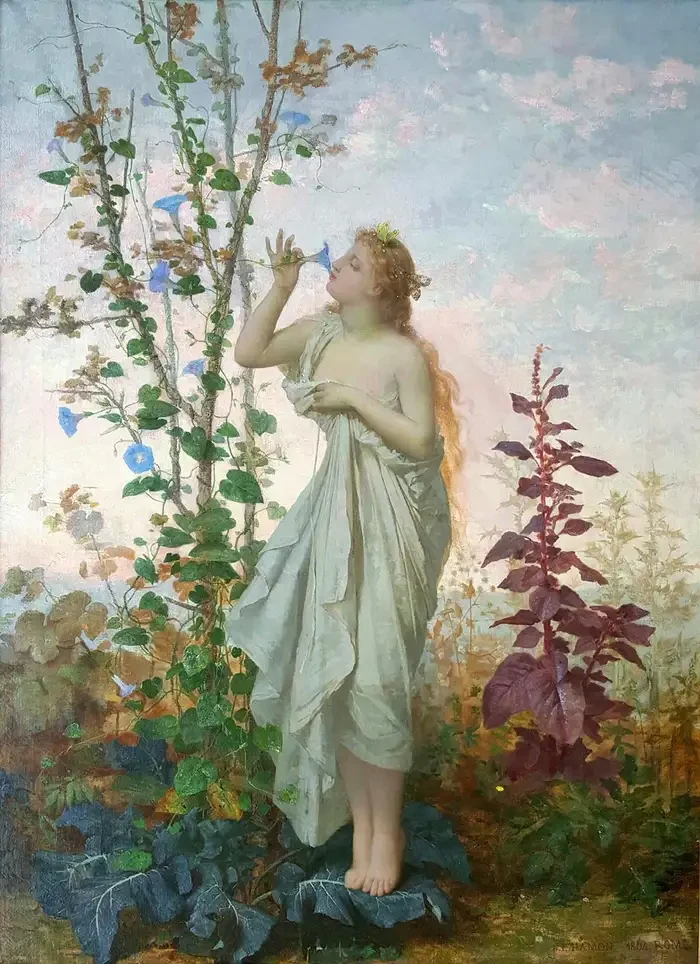
Source: 1stDibs
Titles
Goddess of Renewal
Dawn Bringer
Sky Painter
Abilities
The majestic Aurora commands celestial powers that transcend the comprehension of mortals, as she commands the very cosmos (“Aurora, Roman Goddess of Dawn: Mythology & Powers | Who Is Aurora?”). Aurora's mystical presence operates as a luminous bridge that connects the realms of night and day, offering a celestial crossover that blurs the boundaries between night and the radiant promise of day (“The Goddess Aurora: A Mythical Legend of Light and Dawn”). In her luminous choreography, Aurora performs a cosmic ballet at the threshold of two worlds, reminding humanity of the continuous interplay between the darkness that recedes and the light that emerges, a reminder that reverberates through the very fabric of existence. Aurora was also considered a messenger of the gods, and she was often depicted riding a chariot across the sky to announce the arrival of the sun (“Aurora (Mythology)”).
Characteristics
The embodiment of ethereal and captivating beauty, Aurora's delicate features reflect the wondrous spectacle she unveils with the break of dawn. Adorned in flowing robes that shimmer like the initial rays of light piercing through the veil of night, Aurora's presence instills a unique blend of comfort and awe (“Aurora, Roman Goddess of Dawn: Mythology & Powers | Who Is Aurora?”). Her eyes, often compared to the promise of a new beginning, encapsulate the very essence of hope inherent in the birth of each day (“Aurora – Roman Goddess of Dawn”). Her tranquil demeanor further accentuates this aura of hope and renewal, casting an atmosphere of serenity and bestowing a sense of inner calm upon those fortunate enough to witness her radiance.
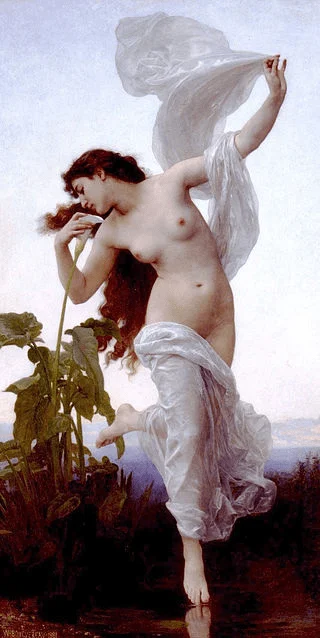
Source: Wikipedia
Traits
Aurora's unwavering commitment to her purpose and duty is enchanting and beautiful. Her dedication to orchestrating the cosmic order is reflected in her gentle touch, delicately stirring the world from its slumber (“Aurora (Mythology)”). As a nurturing caretaker, she ushers in each new day with tenderness, bestowing mortal hearts with the gift of a pristine beginning with each sunrise (“Aurora – Roman Goddess of Dawn”). As a beacon of hope, she symbolizes the unceasing potential for brighter perspectives accompanying the ascending sun. Her celestial essence is forever intertwined with humanity's aspirations, and her profound influence forever touches those who revere her.
Symbols
The symbols of Aurora transcend mere visuals, conveying her divine role as the goddess of dawn and the bearer of light. Her resplendent robes, adorned with shades of pink and gold, reflect the celestial canvas of the morning sky (“The Goddess Aurora: A Mythical Legend of Light and Dawn”). The chariot, an emblem of her swift journey across the heavens, is a well-known symbol of the goddess, drawn by celestial steeds of mythical grandeur (“Aurora, Roman Goddess of Dawn: Mythology & Powers | Who Is Aurora?”). As Aurora's chariot makes its radiant passage, it heralds the triumphant ascent of the sun, illuminating the world with her ethereal touch. Overall, the symbolism of Aurora is a testament to her intimate connection with the morning sky and the light that she brings to the world.
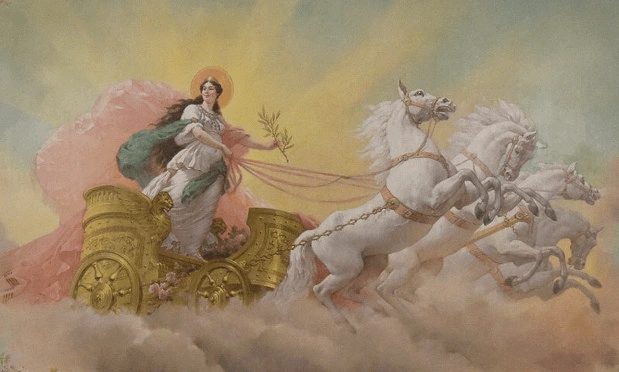
Source: The Mainichi
Festivals and Rituals
The pervasive influence of Aurora is celebrated through a variety of festivals and rituals, each of which honors the goddess in its unique way. Among these, the "Aurora Festival" is a particularly joyful occasion marked by music, dance, and offerings to honor the luminary deity (“The Goddess Aurora: A Mythical Legend of Light and Dawn”). At dawn, devout participants gather to witness the breathtaking spectacle of the sunrise, attributing its splendor to Aurora's benevolent grace (“Aurora, Roman Goddess of Dawn: Mythology & Powers | Who Is Aurora?”). Customary practices further enhance these more prominent festivals carried out daily, serving as a constant reminder of the goddess's unwavering presence and providing supplicants with blessings for a prosperous voyage ahead. Collectively, these customs emphasize the profound bond between mortals and the divine, effectively highlighting Aurora's significant role in those who seek her guidance and benevolence.
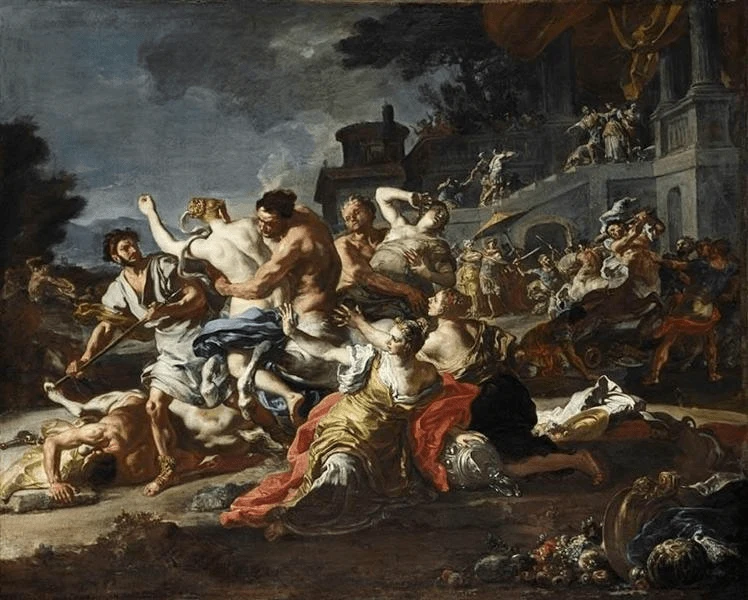
Source: Wiki Art
Legends associated with Aurora
The multifaceted realm of Roman mythology is home to the celestial entity Aurora - the goddess of Dawn. Bestowed with the pivotal role of the herald of daylight, she etches an indelible imprint upon the ancient Roman culture. Her presence has wielded an immense influence, giving rise to compelling legends that continue reverberating across a spectrum of religious and cultural paradigms.
Origin story
The mythical origins of Aurora are steeped in celestial intrigue and divine lineage. Roman mythology tells of Aurora as the daughter of Hyperion, the Titan of light, and Theia, the Titaness associated with sight and clear vision. Her birth from this divine union imbues Aurora with a radiance intricately intertwined with her parents' luminous qualities. As such, she embodies the ethereal essence of light and the clarity of vision, establishing herself as an illuminated bridge between these concepts (“Aurora (Mythology)”).
Aurora's lineage is critical to understanding her pivotal role as the herald of dawn and the bringer of daylight. Her radiance is the enchanting force that illuminates the sky, signaling the end of the night and the beginning of a new day. It symbolizes hope and renewal, inspiring awe and wonder in all who witness it. Without Aurora, the transition from darkness to light would be abrupt and jarring, lacking the beauty and grace that only she can provide. Indeed, her role as the radiant herald of dawn is nothing short of essential, and her mythical lineage only underscores the magnitude of her importance.
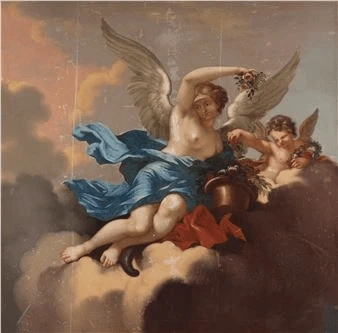
Source: Bukowskis
Aurora's Love and the Shadows of Sorrow: The Tragic Tale of Cephalus and Procris
The tragic tale of Cephalus and Aurora is recounted in Book Seven of Ovid's Metamorphoses. Cephalus, a renowned hero from Athens, was deeply in love with and wedded Procris. Soon after their union, Cephalus went on a deer hunting expedition, where he caught the attention of the Goddess of Dawn, Aurora. Known for her wandering eye and penchant for mortal men, Aurora descended from her mountain abode and abducted Cephalus. Although he remained faithful to Procris, Aurora allowed him to return home, but not before secretly vowing to seek retribution (Tate). She sowed the seeds of jealousy in their marriage, and the consequences were dire. Procris's suspicion and misunderstanding led to a series of unfortunate incidents in a heart-wrenching turn of events.
During a hunting trip, Procris trailed Cephalus and, in a case of mistaken identity, was fatally wounded by him with a spear. The arrow, intended for what was perceived as a wild animal, resulted in the tragic loss of Procris, concluding a tale of unintended consequences and the collision of emotions within the realm of myth (“The Goddess Aurora: A Mythical Legend of Light and Dawn”). The poignant legend serves as a reminder of the intricate threads that weave human emotions and cosmic forces within the fabric of mythology, encapsulating the ethereal allure of Aurora's love and the shadows of sorrow that can shroud even the most luminous tales of romance.
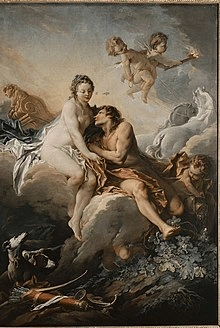
Source: Wikipedia
The Tragic Tale of Tithonus: A Mortal Granted Immortality, but Deprived of Youth
As per ancient Greek tradition, subsequently adopted by Roman poets, a myth tells us that Aurora, the goddess of dawn in Roman mythology, fell in love with Tithonus, the Prince of Troy. It is worth noting that Tithonus, being a mortal, remained subject to the inevitable passage of time and the certainty of aging and eventual death. In her divine yearning for eternal togetherness with her beloved, Aurora approached Jupiter, the chief of the Roman gods, imploring him to grant Tithonus the gift of immortality. In his benevolence, Jupiter acceded to Aurora's earnest request (“The Goddess Aurora: A Mythical Legend of Light and Dawn”).
Despite the importance of Aurora's request for Tithonus's immortality, her plea needed to be revised in that she should have asked for the concurrent gift of eternal youth. As a result, Tithonus was granted immortality but was forever deprived of the perpetual vitality of youth. Over time, he suffered from the ravages of age without any respite, gradually deteriorating until he was eternally old, burdened with the weight of countless years. Moved by her deep compassion for Tithonus, Aurora devised a transformation that would offer him some solace in the face of the unrelenting passage of time. She transformed him into a cicada, granting him an existence that provided a semblance of relief from the never-ending aging process that had befallen him (“The Goddess Aurora: A Mythical Legend of Light and Dawn”).
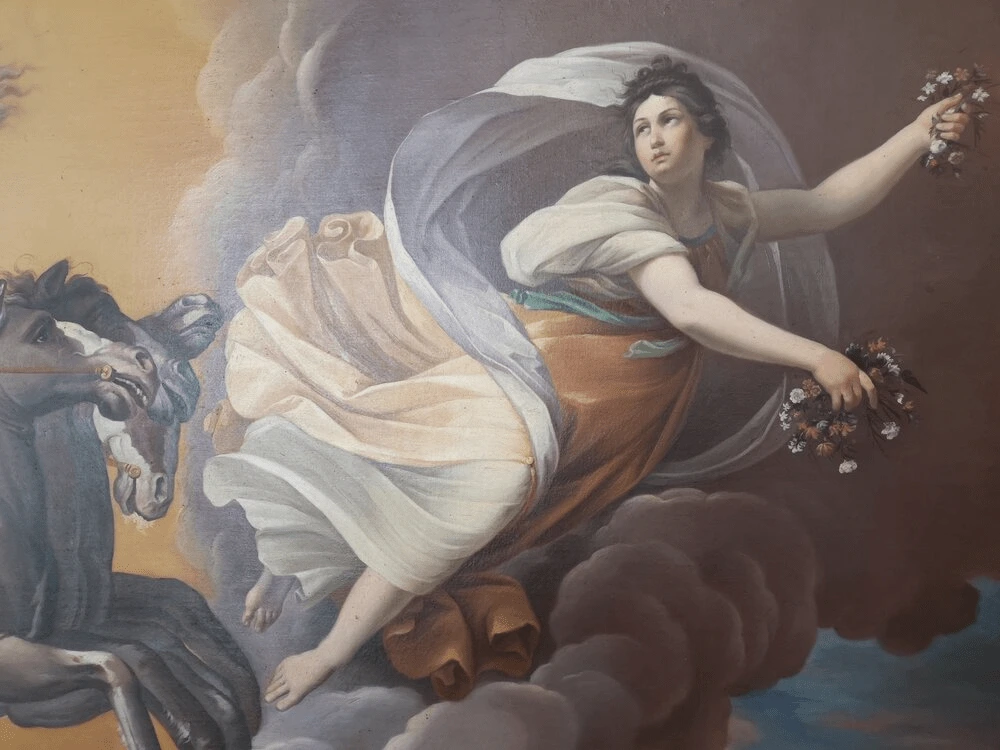
Source: Reepham Antiques
Influences of other religions/cultures on Aurora
Aurora's transcendent presence extends beyond the confines of Roman and Greek mythologies, leaving an indelible mark on diverse religious and cultural narratives. Within Roman culture, Aurora's luminous character finds resonance with dawn goddesses in other mythologies, fostering intercultural connections. These connections become evident in the likening of Aurora to Ushas in Hindu mythology and Eos in Greek mythology, both of whom share the role of heralding the dawn. Such parallels underscore humanity's shared fascination with the break of day - a symbol of the victory of light over darkness and the timeless rejuvenation cycle (“Aurora, Roman Goddess of Dawn: Mythology & Powers | Who Is Aurora?”).
Aurora's cross-cultural significance illustrates the enduring allure of the dawn as a metaphor for optimism and renewal, transcending geographical and temporal boundaries to captivate the collective human imagination.
Modern appearances
The legacy of Aurora endures in contemporary times, manifested through diverse artistic expressions, literature, and cultural representations. Aurora's essence remains alive through works of art that capture the delicate hues of dawn and literary pieces that draw upon her symbolism of hope and new beginnings. In present times, she is a muse for poets, painters, and creators who seek to encapsulate the magic of daybreak in their creations. Aurora's timeless allure finds expression in modern art, where she graces canvases and sculptures with her ethereal presence. The subtle hues that herald her arrival are expertly captured by artists who endeavor to replicate the enchantment of dawn on their chosen mediums. Furthermore, writers continue to derive inspiration from Aurora's symbolism, infusing their prose and poetry with the optimism and renewal associated with her character. Though no longer worshiped in the same tradition as in ancient times, Aurora's influence persists in contemporary culture.
Final thoughts
Aurora, the revered Roman goddess of dawn, embodies the intricate interplay between myth, nature, and human aspirations. Legends that trace her origin, love stories, and cosmic significance have woven an enchanting tapestry of mythos. Aurora's influence extends beyond her mythological boundaries, resonating with other cultures and religions, holding the hope and promise she embodies dear. As the radiant harbinger of dawn, Aurora's presence endures, leaving an indelible mark on the human imagination through art, literature, and cultural celebrations. Her legacy is a reminder of the perpetual cycle of light, life, and renewal that the goddess embodies—a timeless gift that shines brightly across the ages.
References
“Aurora (Mythology).” Wikipedia, 15 May 2020, en.wikipedia.org/wiki/Aurora_(mythology).
“Aurora – Roman Goddess of Dawn.” Symbol Sage, 20 Nov. 2020, symbolsage.com/roman-goddess-of-dawn/.
“Aurora, Roman Goddess of Dawn: Mythology & Powers | Who Is Aurora?” Study.com, 2023, study.com/academy/lesson/aurora-roman-goddess-dawn-mythology-powers.html.
Tate. “‘Cephalus and Aurora (1)‘, Leon Kossoff, 1998.” Tate, www.tate.org.uk/art/artworks/kossoff-cephalus-and-aurora-1-p11690#:~:text=The%20story%20of%20Cephalus%20and. Accessed 1 Sept. 2023.
“The Goddess Aurora: A Mythical Legend of Light and Dawn.” Aurora Academy, www.auroracourses.eu/the-goddess-aurora-a-mythical-legend-of-light-and-dawn. Accessed 1 Sept. 2023.
Vesta: Goddess of the Hearth and the Home

Source: Star Sign Style
In ancient Roman mythology, the Goddess Vesta held a position of utmost respect and veneration. As the protector of the sacred hearth fire and a symbol of immense importance in Roman households, Vesta’s influence extended far beyond the confines of domestic duties. Instead, it was integrally woven into the very fabric of Roman society, serving as an indispensable thread in the intricate mosaic of cultural norms and spiritual traditions that constituted the ancient Roman way of life. Vesta was a guiding light for all those who sought to live by the will of the gods, and it is no exaggeration to say that without her watchful presence, the Roman Empire would not have been the same.
Overview of Vesta
As the Goddess of the Hearth, Vesta represents the warmth and illumination of the sacred fire that was central to Roman households and communities (Wikipedia Contributors). Her name is rooted in the Proto Indo-European *wes, meaning “to dwell” or “stay,” which references her association with the home (Apei). Vesta was also recognized beyond domestic confines, with her presence invoked during meals, gatherings, and family ceremonies to foster unity and harmony within households. Additionally, she was venerated as the guardian of the city and state, with the perpetual flame in her temple symbolizing the very heart of Rome and embodying its vitality and endurance (“Vesta”).
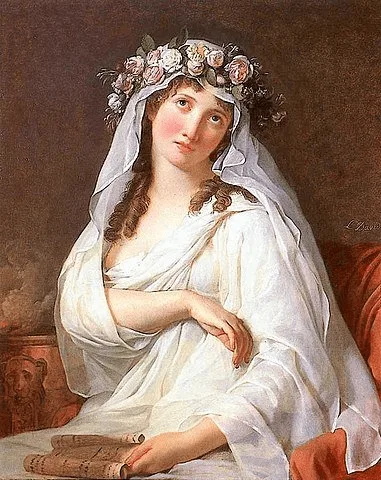
Source: Celebrate Pagan Holidays
Titles
Goddess/Guardian of the Hearth
Guardian of the City
Goddess of Heaven
Abilities
As Guardian of the Hearth, Vesta possesses unique abilities to bestow warmth and sustenance, fostering unity and a sense of belonging among the Romans (Wikipedia Contributors). Her influence extended beyond the physical realm, offering spiritual nourishment and solace to those seeking a connection with their divine heritage. Vesta held sway over the city's welfare through the eternal flame at her temple, guiding Rome's destiny (Kabir).
The significance of the sacred fire was broader than its practical applications. It served as a channel through which Vesta's influence reached beyond households, extending to the heart of Rome itself ("Vesta"). The luminous glow of the eternal flame symbolized more than mere light; it was a beacon that guided the city's path. As such, Vesta's role as the guardian of the hearth was paramount to Roman society, and her presence was revered as a source of strength and guidance.
Characteristics
The portrayal of Vesta in artistic depictions is often characterized by a sense of tranquility and dignity, with her symbolic attributes embodied in the form of flowing robes that represent modesty and purity ("Vesta"). As the revered guardian of the hearth and home, her noble bearing exudes a commanding presence that resonates within private abodes and the broader Roman community. This representation positions Vesta as a stabilizing force, reflecting the essence of the hearth's steadying influence in a manner befitting her exalted status. It is through her serene and authoritative demeanor that Vesta imparts a sense of calm and order, embodying the very essence of Roman values and virtues.
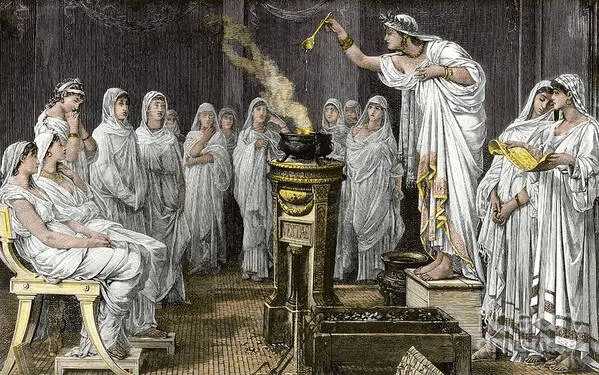
Source: Bridgerman Images
Traits
The depictions of Vesta's personality traits are strikingly reminiscent of the very essence of the hearth. Her nurturing and comforting character, combined with an unwavering commitment to her role as a guardian of the household's sanctity, embodies the Roman virtuous matron ("Vesta"). Her steadfastness, akin to the dedication necessary in tending the eternal flame, mirrors the hearth's unwavering warmth (Kabir).
Moreover, Vesta's selflessness and commitment to the community epitomize the Roman philosophy of collective well-being. By prioritizing the needs of the society above her own, she exemplifies the spirit that connects families and individuals around the communal hearth. This self-sacrificing trait resonates with the Roman ideal of harmony and unity, where each member contributes to the greater good (Apei). Vesta's traits embody the nurturing, selfless, and virtuous aspects that anchor the Roman way of life.
Symbols
The intricate web of symbols that adorned Vesta's divine significance reflected her profound cultural and spiritual influence. At the forefront of these symbols stood the perpetual sacred fire that blazed within her temple, representing the unbreakable bond between the goddess and the Roman state (Madeleine). This eternal flame was a beacon of illumination in the spiritual realm and a guiding force in shaping the fate of Rome (Kabir).
Furthermore, Vesta's association with the hearth and its associated tools, such as the cooking pot and distaff, held deep symbolic value ("Vesta"). These symbols emphasized her pivotal role in domestic life, encapsulating the practical aspects of daily existence and the spiritual and communal dimensions that radiated from the heart of the home (Apei). Vesta's presence extended beyond the tangible realm through these symbols, weaving a rich narrative that intertwined the mundane with the divine and the familial with the cultural.
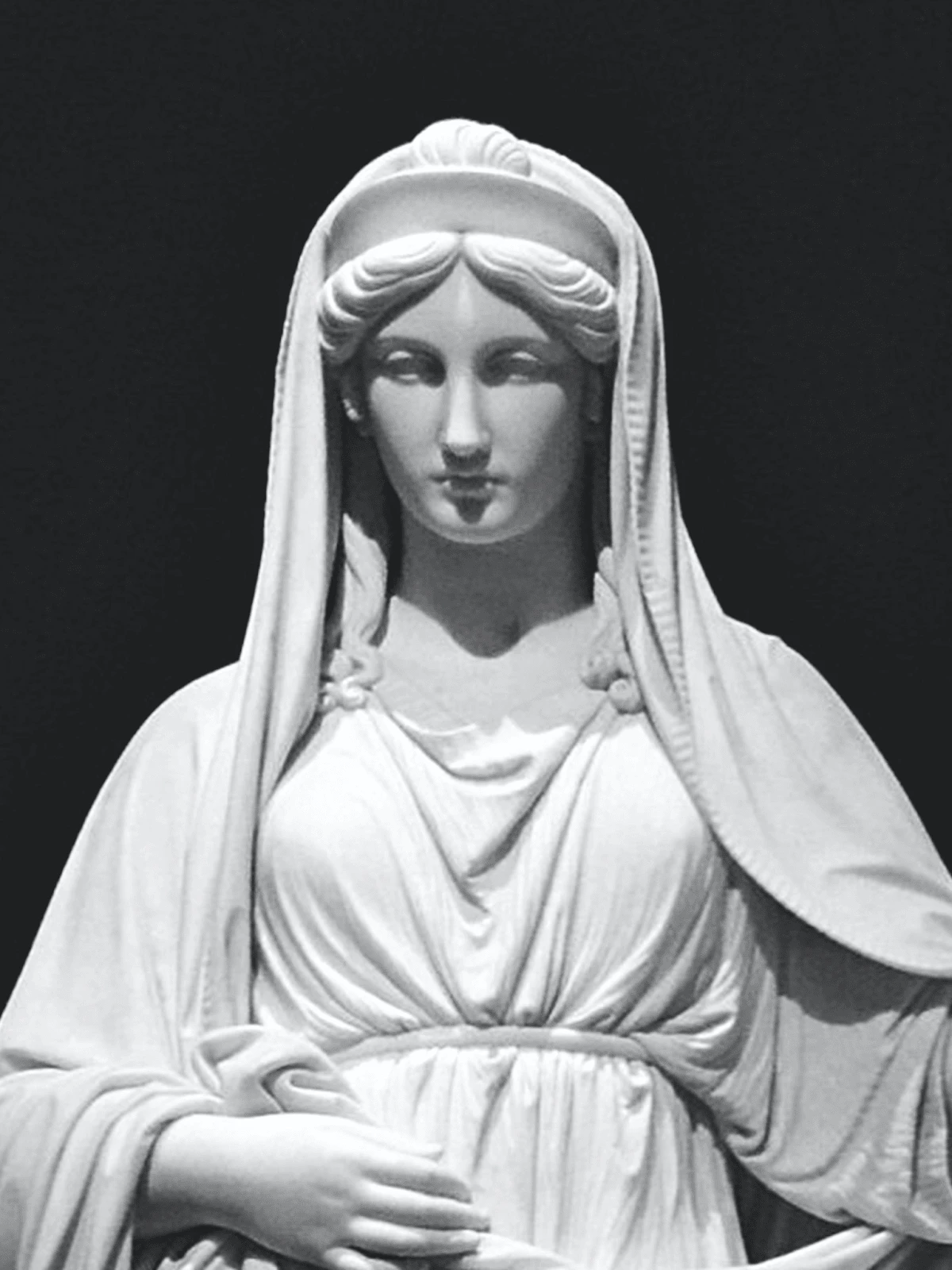
Source: Mythopedia
Festivals and Rituals
A prominent festival that celebrates the Goddess of the Hearth is the Vestalia, a multi-day event dedicated to venerating Vesta and upholding the sanctity of the hearth. During this period, the Vestal Virgins, an esteemed group of priestesses devoted to Vesta, performed meticulously crafted rituals to purify the temple and maintain the eternal flame. The Penus Vestae, an exclusive inner sanctum of Vesta's temple, is opened solely to the Vestal Virgins during this time, further emphasizing the exclusivity of their profound connection with the goddess.
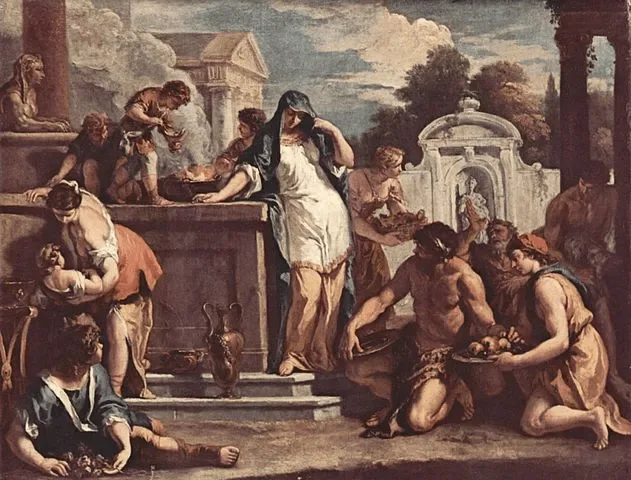
Source: History and Archaeology
Legends associated with Vesta
In the annals of ancient Roman mythology, few deities hold a candle to the profound significance of Vesta, the revered Goddess of the Hearth. Venerated as the guardian of the sacred fire, she symbolized the heart of Roman homes; her influence extended far beyond mere mythology. Vesta's enduring legacy is a potent symbol of domesticity, purity, and spiritual devotion that endures to this day.
Origin story
Within Roman mythology, the diverse narratives that weave through the origins of Vesta reflect the intricate evolution of ancient beliefs. One prevalent account attributes her birth to Saturn and Ops, solidifying her position as an ancient deity in the Roman pantheon ("Vesta"). This lineage symbolizes Vesta's role as a guardian of the sacred fire. However, many believe that Vesta is the daughter of Jupiter and Themis (Madeleine). These varied accounts only add to the mystique and complexity of the goddess, who remains a prominent figure in Roman mythology.
These multiple origin stories' existence underscores Roman myth's malleability and showcases the diverse cultural influences that contributed to the tapestry of Vesta's character and significance. Such varied accounts provide insight into the layered nature of Roman belief systems, where regional distinctions and evolving cultural dynamics played a role in shaping Vesta's legend. Consequently, the spectrum of origin narratives enriches her mythos, enhancing her status as a timeless guardian of the hearth and an emblem of unity within Roman society (Kabir).
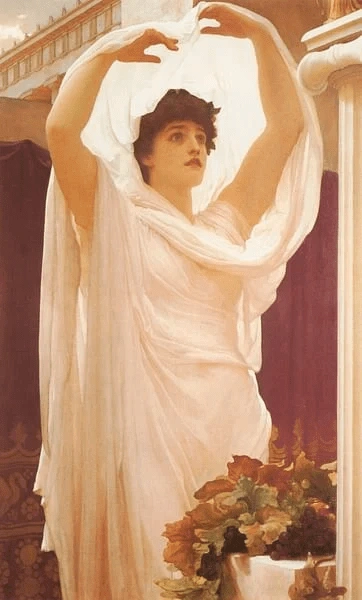
Source: World History Encyclopedia
The Sacred Flame: The Legend of Vesta and the Vestal Virgins
This legend of Vesta revolves around the origin of her sacred flame and the subsequent appointment of the Vestal Virgins, who were priestesses entrusted with her service. As the story goes, Prometheus gifted Vesta with a radiant flame, representing the warmth of a hearth that endures. In gratitude for this divine offering, Vesta made a solemn vow of chastity and devoted herself entirely to maintaining the eternal flame's vitality and upkeep (Apei)
Prometheus's gift not only ignited the physical fire within her temple but also instilled the spiritual significance of the hearth. Vesta's pledge of purity symbolized her commitment to preserving the sacredness of the flame, making it a reflection of her unwavering dedication to the Roman community and its welfare (Madeleine). This legend highlights her role as a symbol of continuity, devotion, and unity, encapsulating the essence of the hearth's nurturing warmth within the physical and spiritual realms.
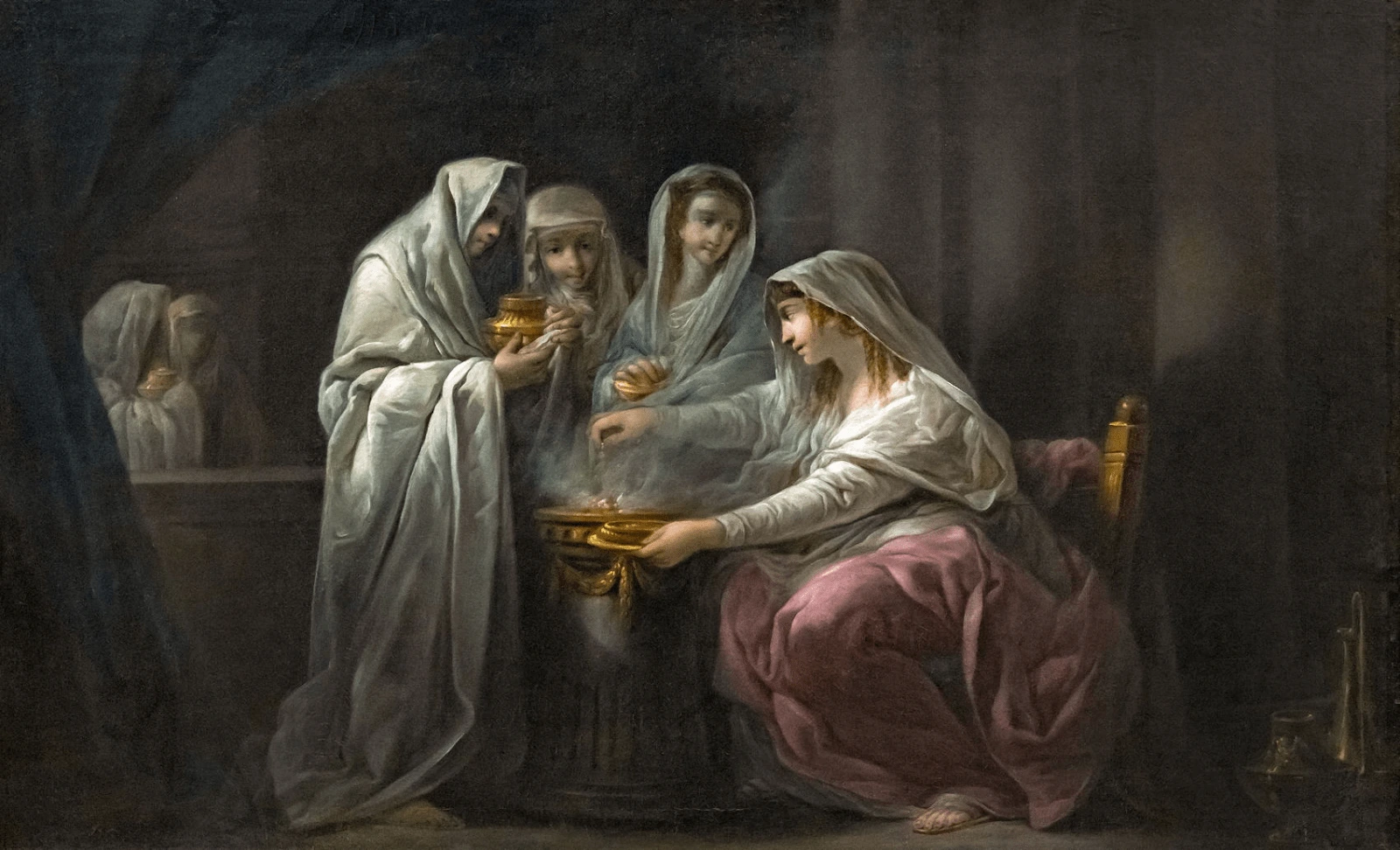
Source: The Eclectic Light Company
The Unyielding Commitment of Vesta: A Tale of Purity and Devotion
Once upon a time, in the pantheon of Roman gods and goddesses, there existed a legend that spoke of the unyielding commitment of Vesta, the Goddess of the Hearth, to her sacred vow of chastity and devotion. The tale narrates how Neptune and Apollo, enamored by Vesta's beauty and virtues, approached her with love. However, Vesta, true to her vow, rejected their advances. This caused concern among the gods, for their discord could have disrupted the divine order. To avert this, Jupiter, the king of gods, intervened and transformed Vesta into a sacred flame, symbolizing her eternal purity and untouchable nature. This transformation preserved Vesta's vow and further cemented her status as a powerful and steadfast deity, embodying the ideals of purity and commitment central to Roman society (Madeleine).
The legend of Neptune's and Apollo's love for Vesta is a captivating narrative highlighting Vesta's significance as a symbol of purity and devotion and her unwavering dedication to her role as the guardian of the hearth.
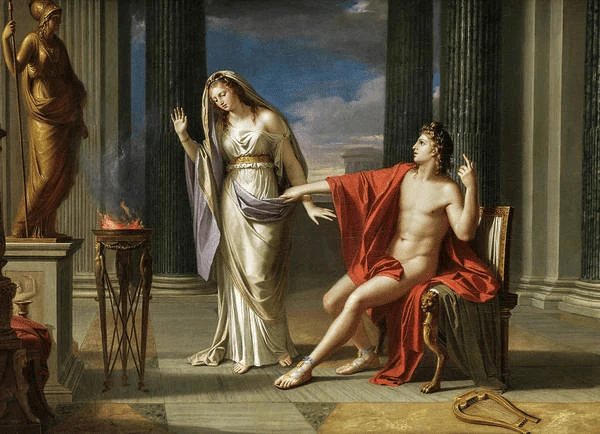
Source: Fine Art America
Influences of other religions/cultures on Vesta
Vesta's divine presence transcended Roman civilization's cultural confines and resonated with broader mythological narratives. In Greek mythology, the cult of Hestia mirrors Vesta's role as the guardian of the hearth, aligning their identities and attributes (Kabir), thereby emphasizing the universality of the concept of an eternal flame and a guardian deity that watches over the sanctity of the home and its hearth fire.
The convergence of Vesta's persona with Hestia underscores the timeless significance of these deities across different civilizations. The hearth, a fundamental element of human habitation, has become a focal point for spiritual and communal connections in various cultures. Vesta and Hestia's embodiment of this symbolism is a testament to the shared human need for warmth, unity, and sustenance, irrespective of cultural boundaries. The interweaving of these parallel narratives amplifies the enduring resonance of the hearth goddess archetype, enriching our understanding of the spiritual and cultural underpinnings of diverse societies.
Modern appearances
The enduring resonance of Vesta as a symbol of hearth and home serves as a poignant reminder of the core values that anchor families, communities, and societies. Her persona encapsulates the warmth, unity, and stability that these concepts represent, evoking a sense of nostalgia for an idyllic past in literature and personifying the heart of a home as a sanctuary of comfort and togetherness in art. Vesta's timeless appeal speaks to people's innate yearning for connection and security, transcending historical epochs and serving as a potent symbol of enduring human values in modern times.
Final thoughts
The goddess Vesta is the keeper of the hearth and symbolizes purity, unity, and eternal flame. Her stories have reverberated through the ages, speaking to her divine origins and role as a guardian of harmonious ideals across cultures. Vesta remains an inspiration for modern representations and narratives from ancient times to the present day. The flame that burns eternally in her temple represents the heart of Rome. At the same time, Vesta represents the heart of humanity, connecting us to our past, guiding us through the present, and illuminating the path towards a nurturing and harmonious future.
References
Apei, Thomas. “Vesta.” Mythopedia, mythopedia.com/topics/vesta.
Kabir, Syed Rafid. “Vesta: The Roman Goddess of the Home and the Hearth | History Cooperative.” History Cooperative , 23 Nov. 2022, historycooperative.org/vesta-goddess/.
Madeleine. “Who Was Vesta, the Goddess of the Hearth? -.” Theoi, 13 Sept. 2019, www.theoi.com/articles/who-was-vesta-the-goddess-of-the-hearth/.
“Vesta.” World History Encyclopedia, www.worldhistory.org/Vesta/.
Wikipedia Contributors. “Vesta (Mythology).” Wikipedia, Wikimedia Foundation, 14 Nov. 2019, en.wikipedia.org/wiki/Vesta_(mythology).
Bellona: Goddess of War
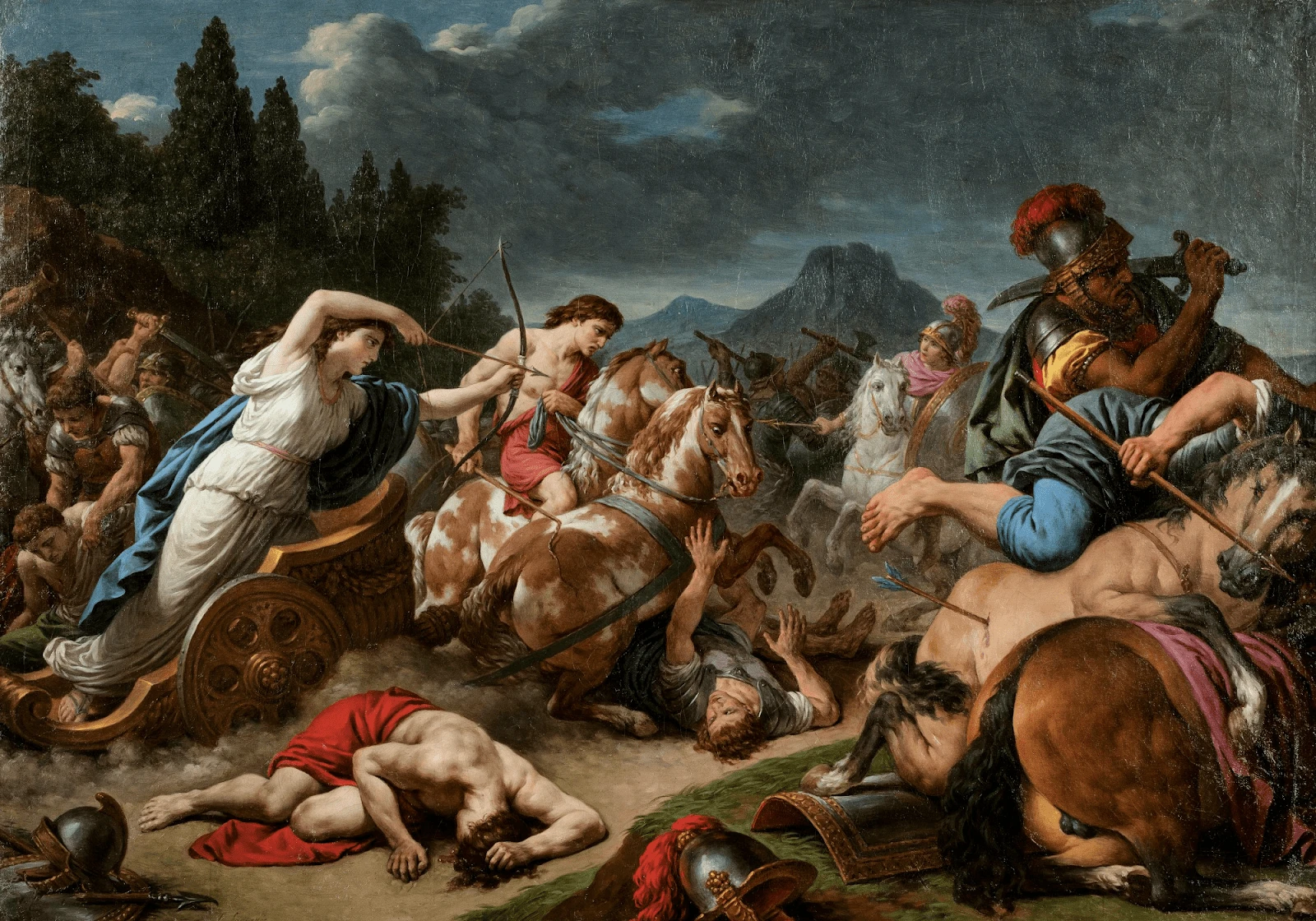
Source: Sothebys
The Goddess of War, Bellona, holds a commanding and unyielding presence in Roman mythology, embodying the essence of war and conflict. With a rich and storied history steeped in the martial traditions of ancient Rome, she represents the unrelenting brutality and overpowering might that accompany the ravages of warfare. Throughout history, military commanders and warriors alike have turned to Bellona in times of great need, invoking her divine intercession and steadfast support on the battlefield. In the following examination, we delve deeply into the intricate facets of Bellona's character and explore her formidable abilities, striking characteristics, defining traits, and potent symbols. Our exploration also sheds light on the grand spectacles of devotion and homage directed towards her through the lens of significant festivals and rituals that have persevered throughout Roman history.
Overview of Bellona
Bellona is a revered figure in Roman mythology, primarily known for her association with the concept of armed conflict and war. Her name comes from the Latin word "bellum," which means war (“Bellona (Goddess)”), underscoring her deep connection to the subject. Bellona has been worshiped under various names, including "Duellona," emphasizing her association with duels and battles (“Bellona | Encyclopedia Mythica”), and "Bellatrix," signifying her as a fierce and unwavering warrior (“Bellona: Roman Goddess of War History & Beliefs | Who Was Bellona?”).
In essence, Bellona is the deity who oversees the critical moments of combat, guiding warriors toward victory and protecting them from harm. Her role in ancient Roman culture was significant, with many soldiers invoking her name before heading into battle, seeking her divine intervention and protection. Bellona's influence extended beyond the battlefield, as she was also considered the patron goddess of the Roman state and the embodiment of its military might. Her legacy lives on to this day as she continues to inspire and captivate those who recognize the crucial role she played in shaping Roman history.
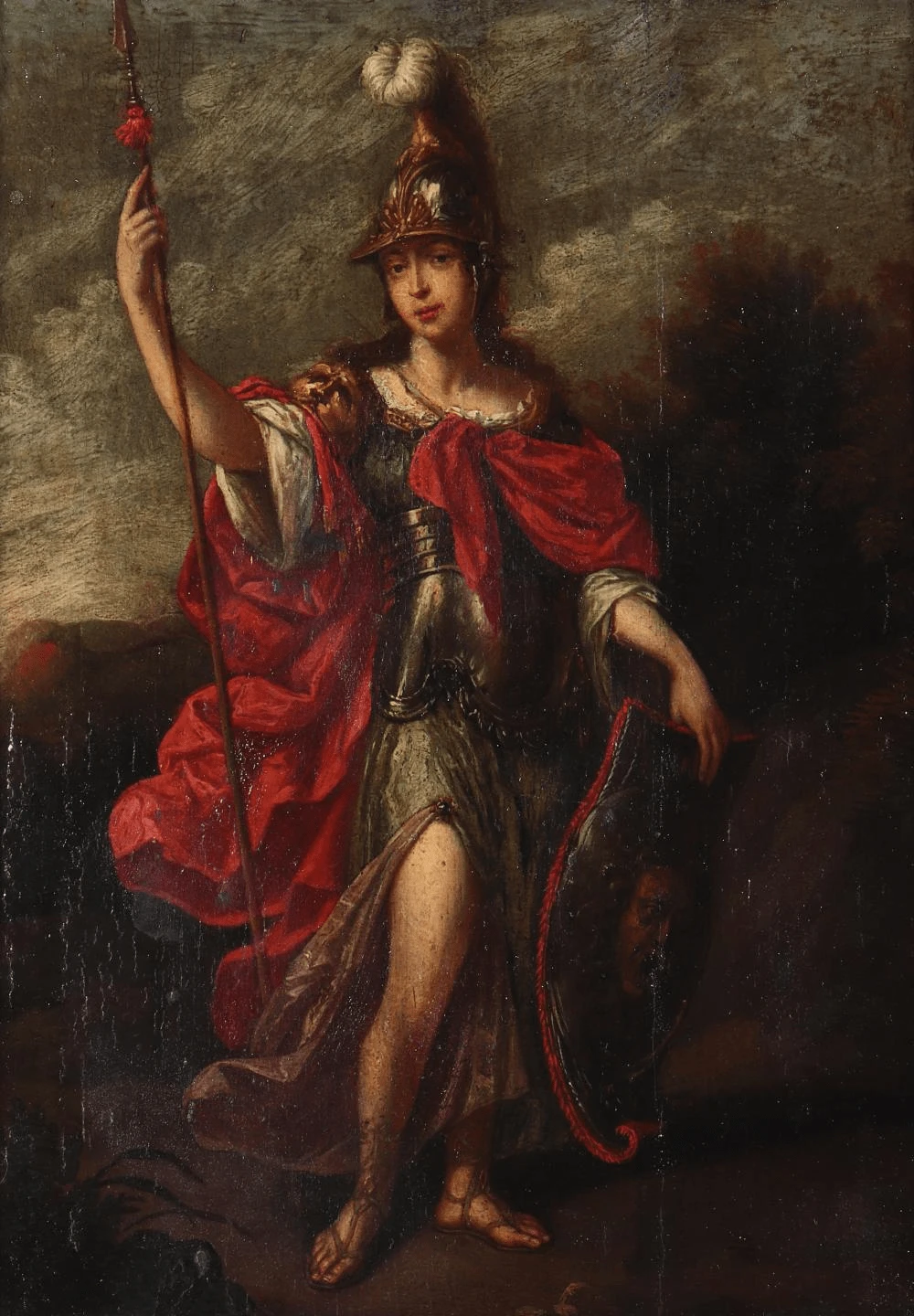
Source: Invaluable
Titles
Protector of Rome
Goddess of War
The Dueler
Lady of Strife
Abilities
Bellona's abilities, deeply revered by Roman soldiers, are as dynamic as the tumultuous theaters of conflict over which she presides. One of her most notable powers lies in her capacity to infuse courage into soldiers' hearts (“Bellona (Goddess)”), bestowing upon them an unwavering resolve and a surge of strength in the heat of battle. This transforms them into formidable warriors who stand undaunted against their adversaries (“Bellona - Roman Goddess of War”). Beyond fortifying individual combatants, the goddess also yields power in the strategic realm. Guiding the minds of military strategists and tacticians, she endows them with the wisdom and clarity necessary to devise effective battle plans (“Bellona | Encyclopedia Mythica”). This divine counsel often proves instrumental in determining the course of a conflict, ensuring that Rome's legions are poised for victory (“Bellona: Roman Goddess of War History & Beliefs | Who Was Bellona?”).
Moreover, Bellona possesses the unique ability to kindle a warlike fervor among her followers. When invoked, she instills an unquenchable thirst for glory and triumph, igniting the spirits of warriors and driving them to confront adversity with unmatched determination (“Bellona: Roman Goddess of War History & Beliefs | Who Was Bellona?”). This aspect of her influence is pivotal in rallying Roman forces and ensuring their unwavering commitment to the cause of victory on the battlefield. Bellona is, in essence, a living embodiment of the martial spirit, providing the physical and psychological strength necessary for triumph in the face of conflict.
Characteristics
Through various artistic forms and sculptures, Bellona is consistently depicted as a stern and formidable woman, unwavering in her countenance (“Bellona: Roman Goddess of War History & Beliefs | Who Was Bellona?”). Often donning resplendent armor and wielding powerful weapons, she presents an imposing figure prepared for the rigors of combat (“Bellona (Goddess)”). Her determined expression, captured in these artful depictions, underscores her steadfast resolve in battle. Bellona's steely gaze mirrors the unrelenting mindset of a warrior who confronts the chaos of warfare with courage and tenacity, emphasizing her role as the patroness of bravery. Her physical representation encapsulates the essence of war - the resolute warrior who stands firm in adversity. Her formidable appearance embodies the ideals of courage, strength, and unwavering determination that define the Roman approach to conflict (“Bellona - Roman Goddess of War”).
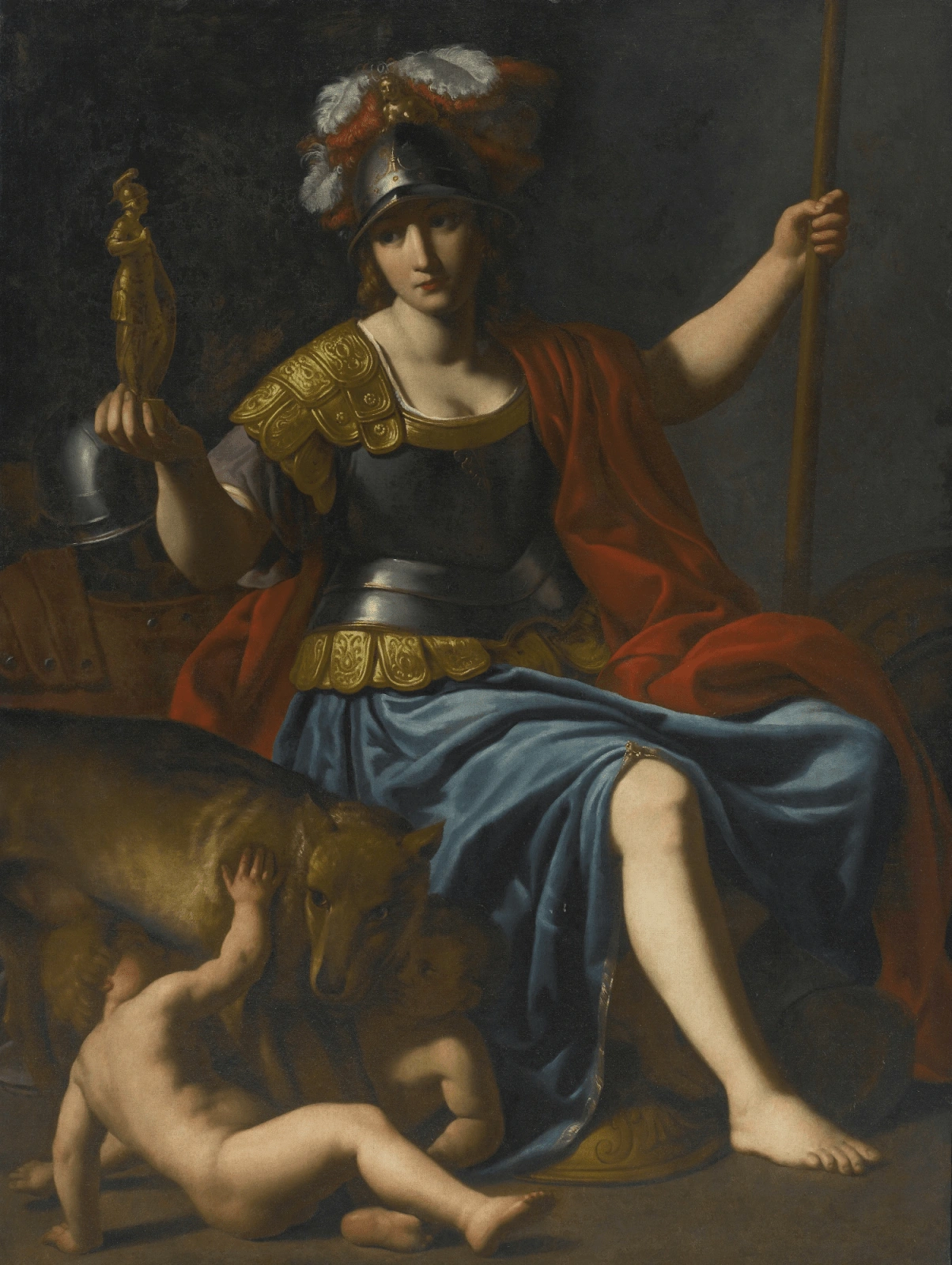
Source: Wikimedia Commons
Traits
The character of Bellona is defined by her unwavering fearlessness in the face of chaos and brutality (“Bellona - Roman Goddess of War”). Serving as a steadfast ally to those who invoke her, she inspires Roman soldiers to confront even the direst circumstances on the battlefield. In addition to her fearlessness, Bellona embodies determination and an indomitable spirit, reflecting the unwavering resolve of warriors who strive for victory even under the most challenging circumstances (“Bellona | Encyclopedia Mythica”). Through her unyielding commitment to pursuing triumph regardless of the odds, Bellona is a symbol of courage and perseverance.
Symbols
The various symbols that are attributed to Bellona, the Roman goddess of war, carry significant significance and are considered iconic. Among these symbols are her sword and shield, which she is often depicted holding, emphasizing her dual role as both a fierce warrior and a protector deity (“Bellona - Roman Goddess of War”). In the midst of battle, these weapons were employed to shield her devotees from harm. Additionally, Bellona is frequently portrayed riding a chariot, which serves as an emblem of her role in guiding and leading the forces of war (“Bellona | Encyclopedia Mythica”). The torch, another important symbol of Bellona, represents her ability to incite conflict and discord, while her attire, often portrayed as bloodstained, serves as a somber reminder of the brutal realities of war (“Bellona (Goddess)”) and the sacrifices made to pursue victory. Collectively, these symbols convey the essence of Bellona's multifaceted nature as a fierce warrior and a guardian deity, her swiftness in the heat of battle, and her intimate connection with the savagery of war.
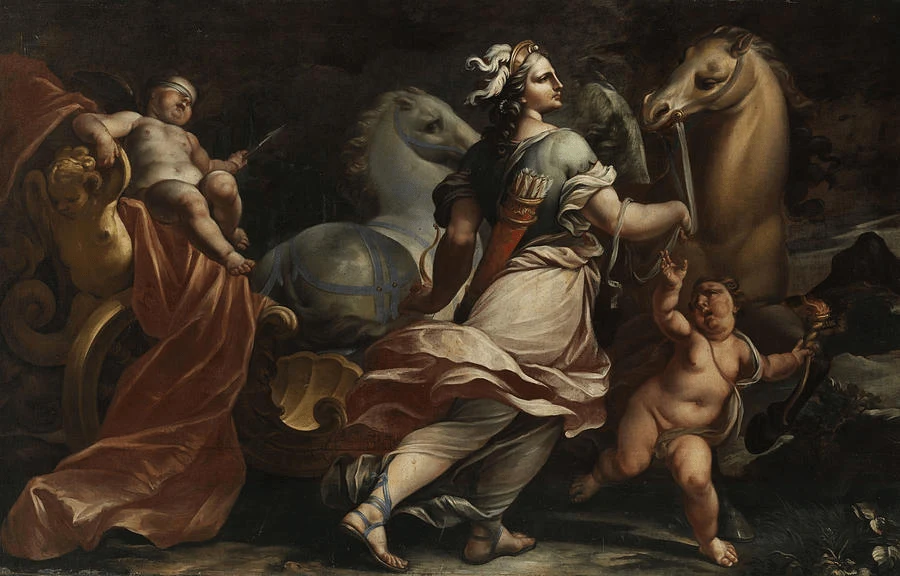
Source: Fine Art America
Festivals and Rituals
The Festival of Bellona was a significant and annual celebration held on June 3rd, serving as a resounding testament to the veneration and influence of the Roman goddess of war (“Bellona | Encyclopedia Mythica”). This grand occasion was a vibrant manifestation of Bellona's profound impact on Roman military culture and the fervent devotion she inspired among soldiers and commanders alike. During the festival, Rome came alive with martial parades and pageantry, as soldiers bedecked in armor marched proudly through the streets, paying homage to the goddess who guided their military endeavors (“Bellona - Roman Goddess of War”).
Gladiatorial contests were a prominent feature of the festivities, where combatants engaged in fierce battles, perhaps mirroring the very conflicts Bellona oversaw. The atmosphere crackled with anticipation as the Roman legions sought her divine blessings for victory in their impending battles. Elaborate sacrifices were made in Bellona's honor, an integral part of the ritualistic proceedings. These offerings were symbolic gestures of gratitude and supplication, acknowledging the goddess's role as the protector of Rome and its warriors (“Bellona: Roman Goddess of War History & Beliefs | Who Was Bellona?”). The Festival of Bellona was a vibrant celebration of martial valor and the enduring partnership between the Roman military and their fierce, unwavering patron deity (“Bellona (Goddess)”).

Source: Wikimedia Commons
Legends associated with Bellona
Bellona, the formidable Roman goddess of war, maintains a unique and enduring place within the pantheon of Roman deities. Her association with the relentless forces of armed conflict is well-established, and the following section delves into rich insights into her origins and multifaceted character, further deepening our understanding of this powerful deity.
Origin story
Bellona, the Roman goddess of war, has an origin story that is shrouded in relative obscurity when compared to more extensively chronicled deities. Nonetheless, her significance within Roman culture as a patroness of war is unmistakable. Variations regarding her parentage add layers of complexity to her origin. In some accounts, Bellona is described as the daughter of Jupiter and Juno, elevating her status to divine lineage and aligning her with the highest gods of the Roman pantheon (“Bellona (Goddess)”). Alternatively, she is portrayed as a sister to Mars, the god of war, further emphasizing her role as a significant martial deity (“Bellona: Roman Goddess of War History & Beliefs | Who Was Bellona?”).
Despite the variations in her parentage, what remains constant is Bellona's core identity as the goddess of war. This enduring aspect of her character underscores her integral place in Roman culture and religion as the embodiment of the relentless forces and unyielding determination that define armed conflict. Therefore, it is clear that Bellona is a powerful guardian and inspirer of Roman warriors, a role that has remained steadfast throughout the centuries.
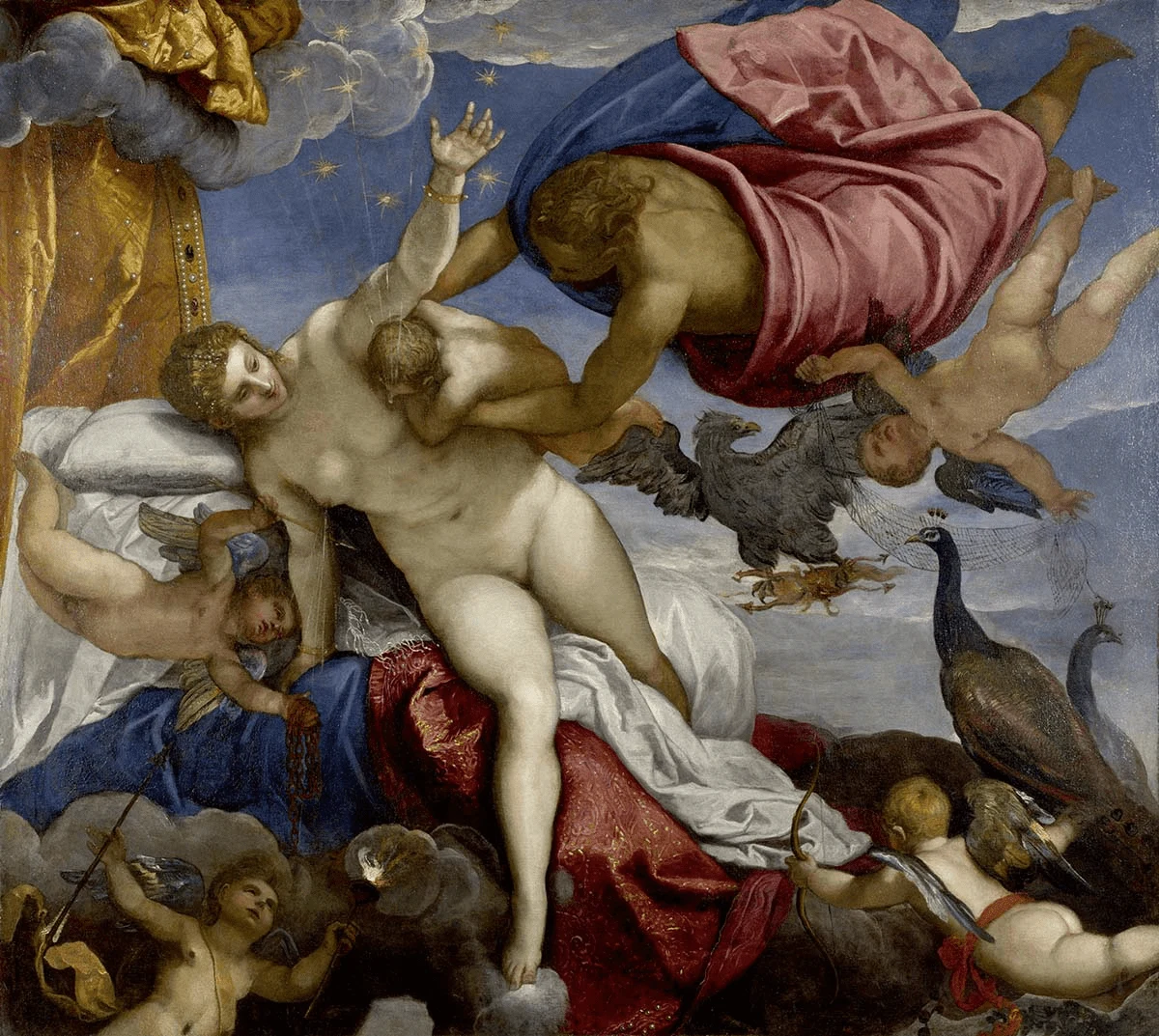
Source: Wikipedia
The Battle of Lake Regillus
The account of Bellona's involvement in the Battle of Lake Regillus delves into the core of Roman military history, recounting a pivotal moment that solidified her reputation as a powerful guardian deity and an inspirational figure for Roman warriors. This legendary conflict, which occurred in the late 5th century BCE, is believed to have marked a turning point in the ongoing struggle between Rome and the Latins.
According to the myth, as the Roman forces faced their formidable Latin adversaries on the battlefield, Bellona rode at the forefront of the Roman army (“Bellona - Roman Goddess of War”). Her presence was not merely symbolic; it was perceived as a tangible source of divine inspiration. Fueled by her unwavering support and protective aura, Roman soldiers exhibited unmatched courage and determination when faced with adversity (“Bellona | Encyclopedia Mythica”).
The influence of Bellona on the outcome of the battle was profound. Her divine guidance led the Romans to a resounding victory over the Latins, securing Rome's position as a dominant power in the region. This legend vividly illustrates Bellona's role as a protective and empowering deity for Roman warriors, reinforcing her reputation as a guardian of Rome during times of conflict. Despite the mythical nature of this tale, it remains a testament to the deep-seated belief in the power of the divine to inspire and protect those in battle.
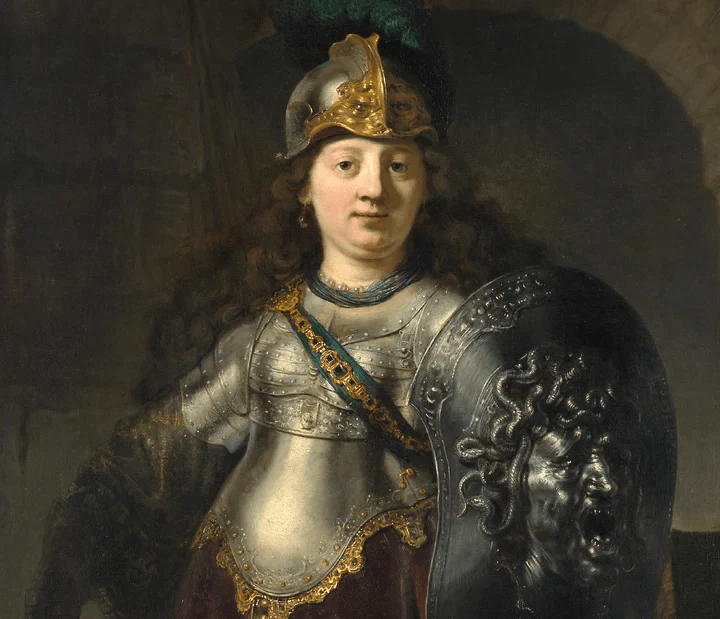
Source: Gallery Thane
Bellona and Mars
The tale of Bellona is one steeped in legend, and her relationship with Mars, the Roman god of war, adds depth to her character and highlights the intricate dynamics that underlie the concept of war within Roman mythology. Bellona and Mars were perceived as counterparts in Roman mythology, embodying Rome's martial spirit. However, their dynamic could not have been more complex and characterized by cooperation and rivalry (“Bellona: Roman Goddess of War History & Beliefs | Who Was Bellona?”).
Various accounts and interpretations of their relationship exist in Roman mythology, each adding complexity to their story. Some narratives depict Bellona as the sister or even the consort of Mars, forging a close and intimate bond between them (“Bellona (Goddess)”). In this context, they were seen as complementary forces, with Bellona representing warfare's fierce, unyielding nature alongside Mars. However, contrasting accounts present Bellona as a distinct and equally potent deity in her own right, emphasizing her independence and unique role as the goddess of war, separate from Mars.
Such ambiguity in their relationship underscores the multifaceted nature of war itself—a complex interplay of cooperation and rivalry, much like the deities who personify it. The legend of Bellona's relationship with Mars emphasizes the complex, multifaceted nature of the fierce spirit that defined Roman culture. As a powerful guardian of Rome, Bellona's role remains undeniable, and her interactions with Mars stand as a testament to the intricate dynamics that underlie the concept of war within Roman mythology.
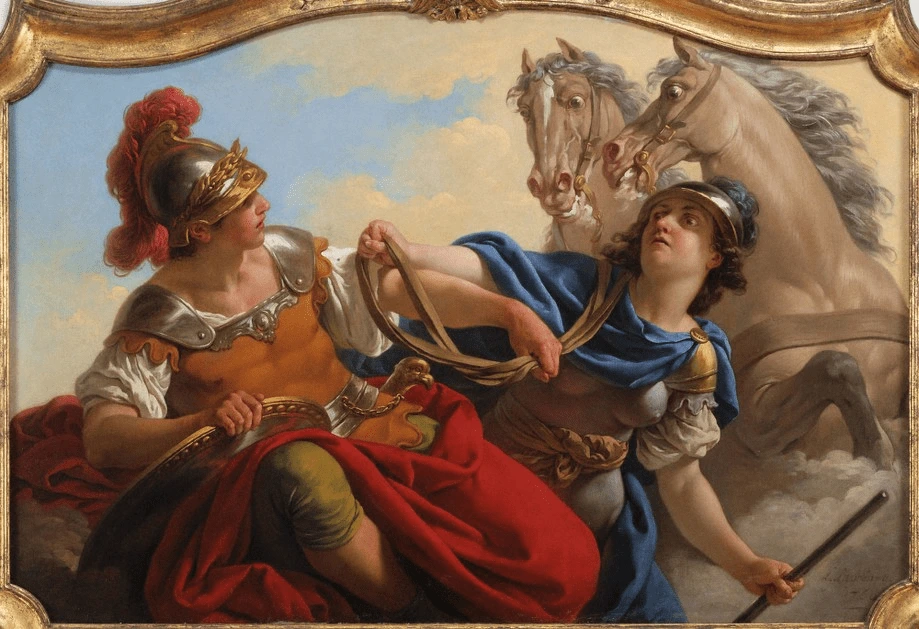
Source: Princeton University of Art
Influences of other religions/cultures on Bellona
Bellona, the Roman goddess of war, illustrates a fascinating amalgamation of Roman and Greek influences, exemplifying the syncretic nature of Roman religious practices. Her characterization and attributes bear striking similarities to those of the Greek goddess Enyo, who, much like Bellona, was closely associated with the chaos and devastation of war. This syncretism between Bellona and Enyo showcases the Roman penchant for merging their beliefs with those of the Greeks, creating a complex interplay of deities and rituals within their religious framework (“Bellona: Roman Goddess of War History & Beliefs | Who Was Bellona?”). It reflects the Roman practice of identifying their gods and goddesses with corresponding Greek counterparts, resulting in shared characteristics and functions.
In the case of Bellona and Enyo, their shared attributes as war deities underscore the universal nature of the martial spirit and the common cultural recognition of warfare's destructive and tumultuous aspects (“Bellona (Goddess)”). This syncretic relationship highlights the interplay of different mythological traditions, enriching the pantheon of gods and goddesses and contributing to the multifaceted religious landscape of ancient Rome. It underscores how Roman religion evolved by blending indigenous beliefs and external influences, resulting in a complex and diverse belief system.
Modern appearances
The veneration of Bellona may have dwindled over the centuries, yet her influence remains prevalent in modern culture, taking on various forms in contemporary art and literature. Bellona, often depicted as a potent symbol of war and conflict, is a testament to the enduring fascination with ancient mythology. In contemporary art, Bellona's image frequently evokes war's powerful and unyielding forces, reminding us of the timeless nature of conflict and the goddess who personified it (“Bellona | Encyclopedia Mythica”).
Similarly, in literature, Bellona's character and name are occasionally alluded to to convey the themes of destruction, war, and the indomitable spirit of warriors. As such, authors and poets use her symbolism to explore human conflict's complex and timeless aspects. Ultimately, Bellona's presence in modern culture is a conduit linking the ancient and contemporary worlds, embodying the enduring fascination with mythology and martial spirit. She remains a symbol that continues to resonate with artists and authors alike as they delve into war's profound and enduring impact on human history and culture (“Bellona | Encyclopedia Mythica”).
Final thoughts
Bellona, the Roman goddess of war, is a multifaceted and highly influential figure in the realm of Roman mythology. Although not as numerous as some of the other deities, her legends and stories elucidate her vital role as a protector and motivator of Roman soldiers. Her origin tale, intricately interwoven with her associations with other deities such as Mars, highlights the complex nature of her character. Bellona's significance extends beyond her ancient worship, as glimpses of her presence can still be observed in contemporary cultural expressions. As a symbol of the enduring spirit of warfare, Bellona remains an integral part of the Roman mythological heritage, embodying the relentless force and unwavering determination that war necessitates.
References
“Bellona (Goddess).” Wikipedia, 9 Mar. 2021, en.wikipedia.org/wiki/Bellona_(goddess).
“Bellona - Roman Goddess of War.” The Vindolanda Trust, www.vindolanda.com/blog/bellona-roman-goddess-of-war.
“Bellona | Encyclopedia Mythica.” Pantheon.org, pantheon.org/articles/b/bellona.html.
“Bellona: Roman Goddess of War History & Beliefs | Who Was Bellona?” Study.com, 2023, study.com/academy/lesson/bellona-roman-goddess-war-history-beliefs.html.
Bona Dea: The Goddess of Healing and Fertility
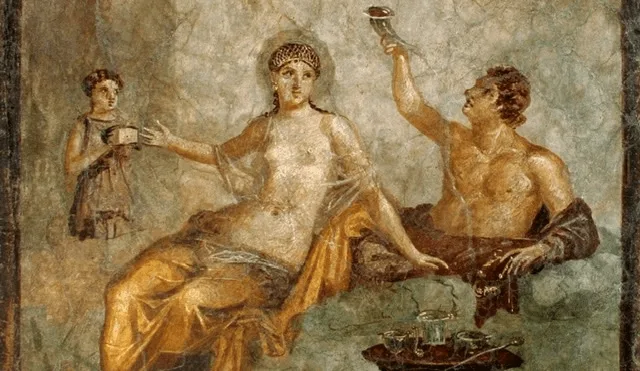
Source: Sarah Holz
Bona Dea occupied a unique and enigmatic realm within the extensive and intricate pantheon of ancient Roman deities, thus earning her unparalleled reverence. Often referred to as "the Good Goddess," Bona Dea's presence in Roman mythology was characterized by an aura of mystery and intrigue. Her identity, shrouded in secrecy, added to her allure, making her one of the most captivating figures in Roman religion and folklore. The name "Bona Dea" carries profound meaning, signifying her intrinsic goodness and her role as a guardian of sacred virtues. Unlike many other Roman deities whose stories and attributes were widely known, Bona Dea remained hidden from the public eye; her true name was never uttered beyond the inner sanctum of her cult.
Overview of Bona Dea
Good Goddess encapsulates the very essence of Bona Dea, emphasizing her benevolence and virtue. Her title is an unequivocal declaration of her inherent goodness, with "Bona" meaning "good" in Latin and "Dea" signifying "goddess (“Bona Dea | Facts, Information, and Mythology”)." Despite her positive attributes, Bona Dea's true identity remains in mystery, with her actual name safeguarded within the confines of her exclusive cult. Hailed as "the Chaste Goddess" in Roman society, underscoring her embodiment of purity and moral integrity, Bona Dea's role extended beyond mere myth, deeply intertwined with the daily lives of Roman women. Her cult, an exclusive domain of women, offered a unique sanctuary for spiritual connection and worship (“The Cult of Bona Dea”).
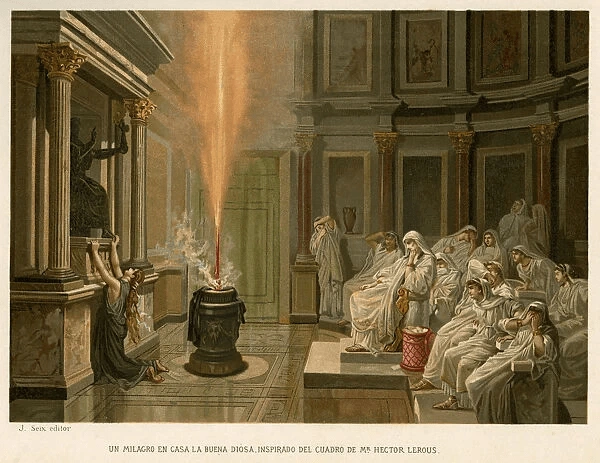
Source: Mary Evans Prints Online
Titles
The Good Goddess
The Chaste Goddess
Goddess of Fertility
Protector of Women
Abilities
Bona Dea possessed a preeminent ability in the realm of fertility, a power of immense significance in the lives of Roman women. She was believed to have the extraordinary capability to bestow fertility and assist in childbirth, rendering her a vital figure for women earnestly seeking to conceive and ensure the continuity of their families (“Bona Dea | Facts, Information, and Mythology”). Furthermore, Bona Dea's influence extended to healing, where she was regarded as a divine source of solace and remedy. She was closely associated with medicinal properties and believed to be able to cure many ailments. Her presence offered comfort to the sick, infusing hope and relief into the lives of those who sought her intervention in times of illness and distress (“Bona Dea”).
In addition to her roles as a bestower of fertility and a healer, Bona Dea was also intricately linked to divination, adding an element of mysticism to her character. Her cult involved specific practices aimed at seeking her guidance and foresight. These rituals were conducted to unravel the mysteries of the future and gain insight into the paths ahead, further solidifying her significance in Roman culture's spiritual and mystical realms.
Characteristics
It is worth noting that while no detailed physical description of Bona Dea exists in historical records, her representation in art and iconography was marked by a common theme - that of an enigmatic, veiled woman. This depiction emphasized her inscrutability and the secrecy that enshrouded her cult. The symbolism of her veiled countenance signified her exclusive connection to women and underscored the notion that her true essence and the secrets of her cult were reserved solely for the initiated female worshippers. Bona Dea was a goddess who existed in modesty, purity, and reverence, enhancing her aura of mystery and sanctity (“Bona Dea | Facts, Information, and Mythology”).
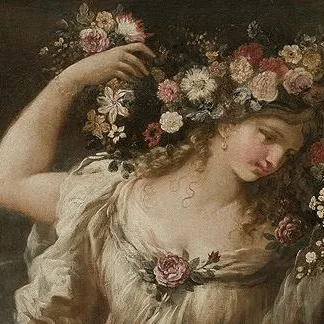
Source: La Bona Dea’s Journal of Everyday Magic
Traits
Bona Dea's character exuded an unmistakable aura of compassion, nurturance, and benevolence that deeply resonated with women in ancient Rome. Her cult members held her in the highest regard, primarily owing to her steadfast commitment to safeguarding women's well-being and moral integrity (“The Cult of Bona Dea”). The goddess's compassionate nature was a source of solace for countless Roman women who turned to Bona Dea for comfort and support during hardship and distress. Her nurturing presence instilled a sense of security and assurance, reinforcing her role as a guardian of women's welfare.
Moreover, Bona Dea's unwavering dedication to upholding moral uprightness was a cornerstone of her character. Roman women revered her not only for her divine powers but also for her embodiment of virtuous values. Her commitment to promoting ethical conduct and maintaining the sanctity of her cult endeared her to her worshippers, cementing her status as a beloved and respected figure within the Roman religious landscape (“The Cult of Bona Dea”).
Symbols
The Good Goddess was often associated with powerful symbols that spoke to her role as a healer and nurturer. Among these symbols, the serpent held particular significance, as it represented healing and wisdom. Serpents were frequently intertwined with Bona Dea's imagery (“Bona Dea”), emphasizing her ability to bring solace and enlightenment to those in need. Another symbolic representation of this goddess was the cornucopia, a symbol of abundance and fertility (“Bona Dea | Facts, Information, and Mythology”). This iconography underscored her influence in matters related to prosperity and the earth's bounty, further highlighting her role as a powerful deity who promoted the well-being and fertility of her worshippers.
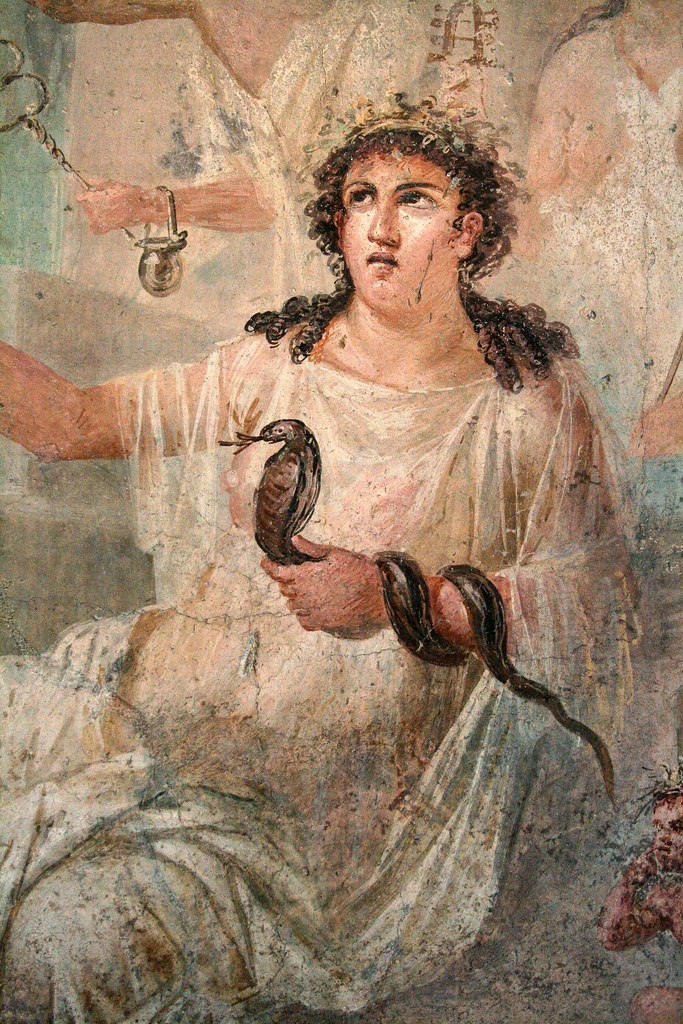
Source: Flickr
Festivals and Rituals
The cult of Bona Dea was an exclusive domain, reserved solely for women, and distinguished by a collection of unique festivals and rituals that played a vital role in Roman society. One of the most significant of these rituals was the "Lupercalia," celebrated in December, during which women gathered within the house of the Roman magistrate or priest responsible for overseeing the cult (“Bona Dea | Facts, Information, and Mythology”). These ceremonies involved the making of offerings, singing of hymns, and the sharing of secret teachings related to the goddess among the initiated women, further shrouding Bona Dea's cult in an aura of mystery and exclusivity (“Bona Dea”).
Another notable celebration was the "May Festival," or "Matronalia," held in May, marked by joyous feasting and the exchange of gifts among women. This festival served as a collective homage to Bona Dea, acknowledging her as a guardian of women's well-being and shared bonds (“Wikiwand - Bona Dea”). These festivities provided a unique and essential opportunity for women to unite, seek the blessings of Bona Dea, and reinforce their sense of community, emphasizing the goddess's role as a unifying and protective force in the lives of Roman women (“The Cult of Bona Dea”).
In essence, the cult of Bona Dea offered a sacred space for women to connect, celebrate, and seek the blessings of a goddess who held a unique and revered place in their lives. The rituals and festivals associated with Bona Dea reinforced the sense of community among women while perpetuating the mystery and exclusivity that characterized her cult in the rich tapestry of Roman religious tradition.
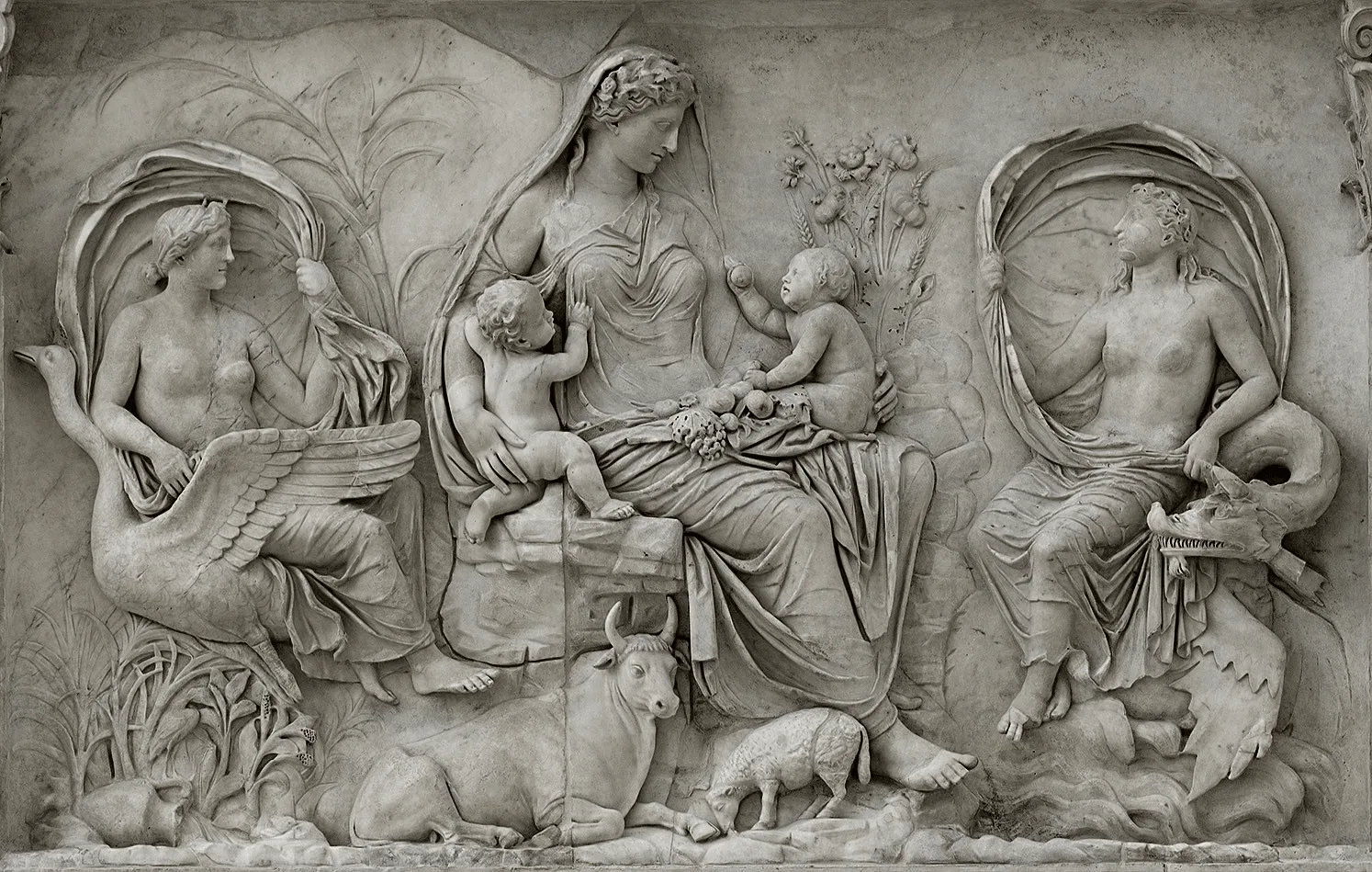
Source: Italian Art Society
Legends associated with Bona Dea
The Roman goddess Bona Dea, known as "the Good Goddess," remains a source of fascination due to her enigmatic nature and complex symbolism. This section delves into the myths surrounding Bona Dea, offering insights into her origins and other compelling stories contributing to her legendary persona.
Origin story
The origin story of Bona Dea, or lack thereof, adds a layer of mystique to her already enigmatic persona. Bona Dea remains an exception in Roman mythology's history, where the birth and lineage of deities were often meticulously chronicled. Unfortunately, no widely acknowledged or definitive account narrates the circumstances of her birth or creation. Instead, her existence remains veiled in obscurity, mirroring the secrecy that cloaked her cult and identity.
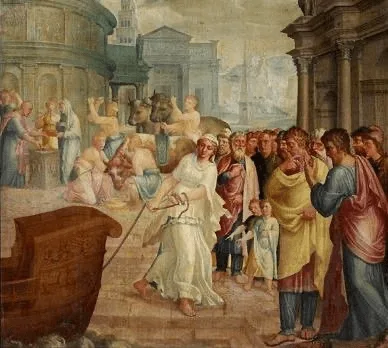
Source: Sarah Holz
The Benevolent and Nurturing Nature of Bona Dea: A Beacon of Hope for the Ailing and Vulnerable
In Roman mythology, Bona Dea was revered for her exceptional ability to alleviate ailments and comfort those in need. As the Good Goddess, she was believed to materialize as a celestial entity, gracing the dreams of the ailing and vulnerable and providing divine guidance on remedies and therapeutic practices. While the origins of this legend lack a definitive source, its thematic resonance endures, illuminating Bona Dea's benevolent and nurturing nature.
This legendary portrayal underscores her pivotal role as a source of assistance and well-being in Roman society, where afflictions and maladies were frequently met with desperation and uncertainty. Bona Dea transcends mere myth in this narrative, becoming an emblem of hope and respite, a celestial beacon for those in physical and emotional distress (“Bona Dea”). Despite the absence of a specific source, the legend reaffirms the goddess's significance as a healer and guardian, perpetuating her status as a revered and cherished figure within the pantheon of Roman deities.
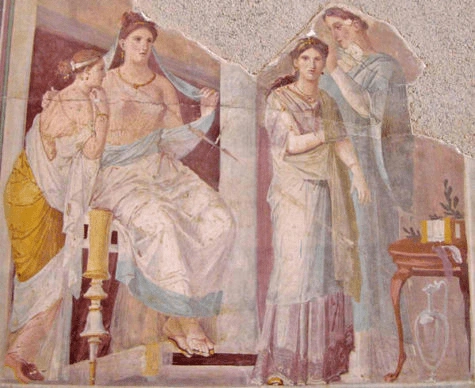
Source: Today in History
The Empowering Essence of Bona Dea: A Guardian of Women
Bona Dea, known as the Goddess of Fertility and the Protector of Women, is significant in Roman mythology. She is renowned as a steadfast guardian of women, particularly during crucial junctures, such as childbirth. It is widely believed that Bona Dea assumed the role of a guiding presence, extending her divine mantle as a protective shield over women during their moments of vulnerability and transition. Although no singular source offers a comprehensive account of this particular legend, its resonant echoes persist in the collective memory of Roman society, underscoring the indelible imprint of Bona Dea's paramount importance in women's lives.
Through this narrative, Bona Dea embodies empowerment and unwavering support during a woman's most delicate and significant phases of life. Her divine presence is a source of strength, fortitude, and assurance, guiding women through the profound experiences of childbirth and other pivotal life events (“Bona Dea | Facts, Information, and Mythology”). Although the tale may not be recounted in explicit detail, its enduring essence emphasizes Bona Dea's unwavering role as a guardian of women, firmly establishing her as a revered and cherished figure in Roman women's hearts and minds throughout the ages.
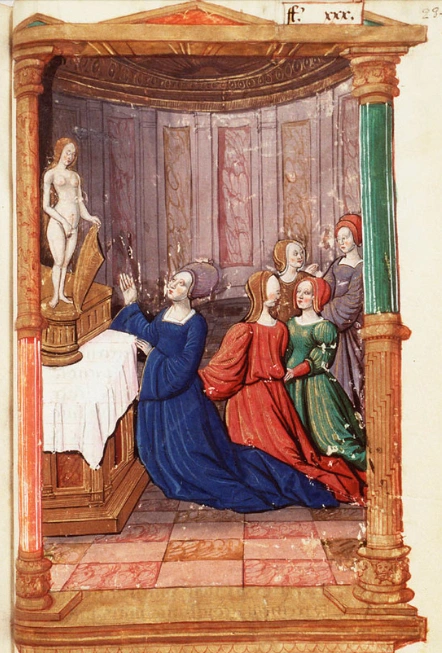
Source: Wikimedia
Influences of other religions/cultures on Bona Dea
While distinctly Roman, the intersection of cultural influences in Bona Dea's mythic character bears subtle marks of external sources that shaped her persona. Greek mythology, in particular, emerges as a potential source of inspiration, offering a glimpse into how foreign traditions may have influenced Bona Dea's roles as a healer and protector. The Greek goddess Hygieia, celebrated as the embodiment of good health and cleanliness, takes center stage in this exploration. The thematic resonances between Bona Dea's attributes and Hygieia's qualities invite speculation about potential cross-cultural exchanges that shaped their mythic identities (“Bona Dea | Facts, Information, and Mythology”). While no specific source explicitly narrates the fusion of these two figures, the dynamic nature of ancient mythologies suggests that deities often evolved through the intermingling of diverse traditions. In light of this, the contours of Bona Dea's character add depth to the intricate interplay of cultural exchanges that shaped her mythic persona.
Modern appearances
The persistence of Bona Dea's legacy is a subtle but perceptible undercurrent in contemporary cultural and academic realms. While the fervent worship once directed toward her has waned, and her temples have become relics of history, her enduring presence is palpable. Scholars and enthusiasts of ancient religions continue to study and contemplate her enigmatic and mysterious tales, examining her role as a healer, protector, and symbol of feminine strength within the broader context of Roman mythology.
In modern literature, art, and scholarly discussions of antiquity, occasional references to Bona Dea can be unearthed as reminders of the enduring impact of ancient goddesses on human culture and imagination. In the interplay between past and present, Bona Dea's legacy endures as an ever-flickering flame that illuminates the rich tapestry of Roman mythology and the timeless fascination with the enigmatic divine.
Final thoughts
Bona Dea, the enigmatic and compelling figure of Roman mythology, remains shrouded in mystery. Her legends reveal her multifaceted roles as a healer, protector, and symbol of feminine strength. The influence of distant cultures further heightens the complexity of her mythic persona. Although her temples may have crumbled, her legacy lives on as a testament to the enduring power of ancient goddesses in shaping beliefs, cultures, and imaginations. In Bona Dea's aura of benevolence, secrecy, and reverence, we are reminded of her timeless presence within the intricate tapestry of Roman mythology.
References
“Bona Dea.” Wikipedia, 29 July 2023, en.wikipedia.org/wiki/Bona_Dea. Accessed 4 Sept. 2023.
“Bona Dea | Facts, Information, and Mythology.” Pantheon.org, pantheon.org/articles/b/bona_dea.html. Accessed 4 Sept. 2023.
“The Cult of Bona Dea.” Women in Antiquity, Women in Antiquity, 27 Nov. 2018, womeninantiquity.wordpress.com/2018/11/27/the-cult-of-bona-dea/.
“Wikiwand - Bona Dea.” Wikiwand, www.wikiwand.com/en/Bona_Dea. Accessed 4 Sept. 2023.
Like this project
Posted Oct 1, 2023
A client hired me to write several informative pieces on Roman Goddesses, and this blog post centers around five different goddesses.
Likes
0
Views
1.7K
Timeline
Aug 21, 2023 - Sep 6, 2023
Clients

Grounded Insights







